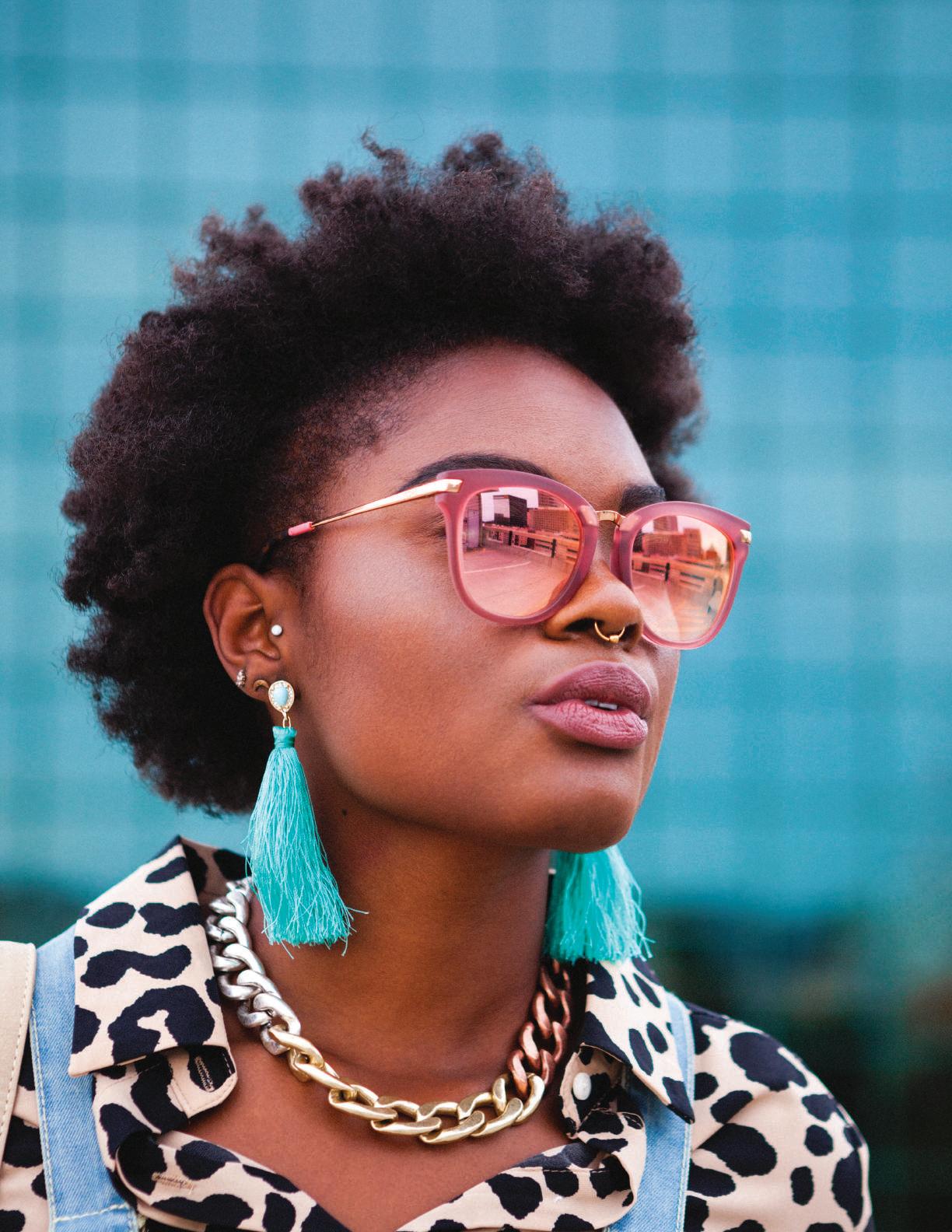
Sugar, Spice & Everything Nice THE PERFECT FALL DRINK New Again RETRO REVISITED COLUMBIA’S QUEER SPACES POST-PULSE Student Magazine of the University of South Carolina Fall 2016
GARNET RIVER WALK UNIVERSITY OAKS
PRIVATE BEDROOMS & BATHROOMS AVAILABLE
FULLY FURNISHED APARTMENTS
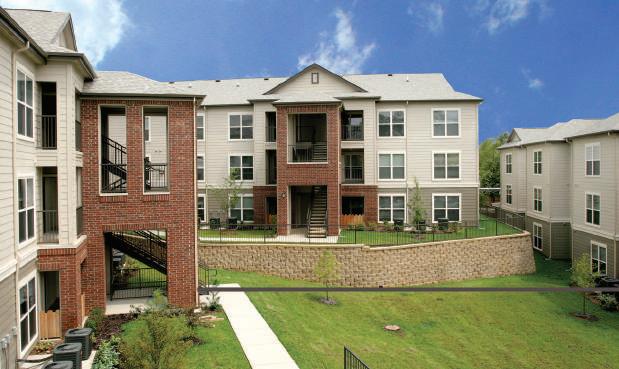
AMENITIES FOR A FIT & HEALTHY LIFESTYLE

ALL UTILITIES INCLUDED
INDIVIDUAL LIABILITY LEASES
ROOMMATE MATCHING AVAILABLE
Apply online today at FORMERLY COLUMBIASTUDENTLIVING.COM Amenities & utilities included are subject to change. Utilities up to a monthly cap. See office for details.
GervaisSt BlossomSt Huger St Assembly St Alexander Rd 48 16 48
NationalGuardRd
STUDENT MAGAZINE OF THE UNIVERSITY OF SOUTH CAROLINA
EDITOR-IN-CHIEF JAKE MARGLE
CREATIVE DIRECTOR CHARLOTTE PRICE
MANAGING EDITOR OLIVIA RESZCZYNSKI
PUBLIC RELATIONS DIRECTOR TYSON BLANTON
ART
ART DIRECTOR RACHEL JOHNSON
STAFF DESIGNER ALEX RUSNAK
STAFF DESIGNER ASHLYN MURPHY
EDITORIAL
ARTICLES EDITOR LOIS CARLISLE
ASSISTANT ARTICLES EDITOR JULIA HOGAN
STAFF WRITER KASEY MEREDITH
COPY CHIEF MADELEINE VATH
PHOTO
PHOTO EDITOR JOSH THOMPSON
ASSISTANT PHOTO EDITOR BRENNAN BOOKER
STAFF PHOTOGRAPHER CHRISTIAN TOLBERT
STYLE
STYLE EDITOR DOMINIC BELLOTTI
STYLE ASSITANT MYLEA HARDY
STYLE ASSITANT CLARA MARZOLF
WEB
WEB EDITOR KATHERINE FINNEY
ASSISTANT WEB EDITOR ROBIN HENDRICKS
DIRECTOR OF STUDENT MEDIA
SARAH SCARBOROUGH
CREATIVE DIRECTOR
EDGAR SANTANA
PRODUCTION MANAGER
DEGAN CHEEK
BUSINESS MANAGER
KRISTINE CAPPS
FACULTY ADVISOR SCOTT FARRAND
CREATIVE SERVICES
WANDA FELSENHARDT
ELIZABETH JENNINGS
EMILY LOR CHARLOTTE PRICE
STUDENT ADVERTISING MANAGER
LOWMAN HARLEY
ADVERTISING REPRESENTATIVES
ADRIENNE COOPER
AMANDA GRANT
KAIT NIEMAN
ANDREW SNIGHT
DREW THIEL
PERRY WEST
Advertising: (803) 777-3018
To contact G&B, email sagandbe@mailbox.sc.edu or visit www.gandbmagazine.com Garnet & Black magazine is produced four times a year by students of the University of South Carolina and is distributed free to members of the university community. All editors and staff members can be contacted at (803) 777-1149. The office is located in Russell House room 339. Email letters to the editor to sagandbe@mailbox.sc.edu or to Garnet & Black magazine, Student Media, 1400 Greene Street, Columbia, SC 29208. Letters should be 250-400 words and must include name, address, phone number and academic information (if applicable). Garnet & Black reserves the right to edit for libel, style and space. Anonymous letters will not be published.
3
CONTENTS PROFILES 08 CONVINCE ME 15 A REGRETTABLE ERASURE 29 ON THE AIR 44 Student researcher, Jory Fleming, dives into science. Poet Laureate, Ed Madden, draws language from the landscape. A poem from "The Lettered Olive." The uprooting of Gonzales Gardens. Don’t be afraid of the "Dark Entries." ALL DOGS GO TO PRISON 10 THAT FAMILIAR FEELING 16 OLD TRENDS, NEW TRICKS 32 EVENTS 46 One student's experience with PAALS. Sweet treats on Cola’s streets. Closing ranks post-Orlando. Revamping your parents’ closet. What to look out for in Columbia this fall. 12 AS YET UNTOLD 21 DOWN THE RABBIT HOLE 40 AlcoholEdu 45 The reinterpretation of the MannSimons site. Zoe Dale sets her future in stone. Making the case for alcohol education. CRISP SIPS FALL BITES 14 THE MORAL STAIN OF DONALD TRUMP 25 POWER TO THE SKANKS 42 OVERHEARD AT PRIDE 47 Fall’s favorite flavors. An opinion piece on the Republican nominee. Local “hurricane
hits the stage. Nothing lasts like a drag queen’s makeup. 4
THOMPSON ANDREIA
Toms sunglasses Copper Penny $119 | Ellie earrings Vestique
| Tri-Collar
Bohemian
|
Bohemian
Deb”
COVER PHOTO BY JOSH
WARDLAW IN
$28
Tri-Tone necklace
$125
Buddy Love Malika Tunic fab’rik $88 | overalls
CONTRIBUTORS
HALEY SPRANKLE
Pimento cheese fries; Kim K’s interdisciplinary business empire; Cynthia Erivo’s voice; Michelle Obama; Four-piece chicken supremes meal, Bosized with seasoned fries and a sweet tea; the children of Stranger Things; The Exposing of Taylor Swift™️
CASSIDY SPENCER
The current election; Kevin Jonas’ whereabouts; that one picture where Kim Kardashian balances a champagne glass on her butt; almond milk; the cloud; when you wake up and your blankets are wrapped completely around you in perfect burrito-like format; how Jay Z got Beyoncé
ELIZABETH JENNINGS
Chuck Bass’ puppy-dog eyes; Pawnee, Indiana; Blake Lively’s hair; Hogwarts; Beyoncé and Blue Ivy; Central Perk; milkshakes and fries
SAVANNAH FISHER
The ghost town of Bodie, California; Dolly Parton; the Japanese Tea Garden; Leopold’s Ice Cream Shop; literally all cats ever; the Mitchell Corn Palace; Elliot Fry’s right foot
SAM MORRIS
Dove dark chocolate; Kate Hudson’s Snapchat; “Parenthood” (the TV show); peppermint oil; homemade guacamole; my dog; Soda City
KATE STUCKY
James Marsden’s eyes; Kanye West; The Other Franco Brother; the costumes from Burlesque; Schrute Farms; the REAL reason the Jonas Brothers split; the world’s largest cupcake
BEN CRAWFORD
“Hamlet”; “The West Wing” (Season 2); New York City; the Parthenon; Salman Rushdie; the Hubble Telescope; Haruki Murakami
YOUR OPINION, WHAT ARE THE SEVEN WONDERS OF THE WORLD?”
SARAH CASSIDY
New Jersey bagels; Michael B. Jordan; putting on sweatpants after shaving your legs; perfectly arched eyebrows; Chance the Rapper; the cold side of the pillow; Twitter accounts dedicated to pictures of pugs
CAROLINE FAIREY
Donald Trump’s spin team; Jimmy John’s delivery team; the USA Olympic gymnasts; my dad’s Twitter game; Laverne Cox in the “Rocky Horror” remake; girls who don’t fall in high heels; salted caramel mocha at Starbucks
LAUREN NIX
The 13th zodiac sign; how a Yeti keeps drinks cold; the fact that Dan was Gossip Girl; people who still don’t believe in global warming; the layout of parking garages; $5 footlongs are not a foot long or $5; the popular page on Vine
KATHLEEN SCHIPANO
No line on Chicken Finger Wednesday; sleeping through class to find out it’s canceled; the red “New Episodes” symbol on Netflix; adjustable thermostats in classrooms; an age-appropriate Spider-Man casting; a Discover Weekly playlist featuring Aaron Carter; the Baja Men
OLIVIA GRIFFIN
King Street; a three-story Nordstrom; an “a-wow-cado bowl” from Yoghut; SCAD; Lily Collin’s eyebrows; kittens; Douglas Booth
ELIZABETH ZIGRANG
Californian coastline; Donald Trump’s hair; raspberries; caffeine; goldendoodle puppies; the Carolina/ Clemson rivalry; red
TORI McANALLEN
Triple-folded potato chips; calligraphy videos; Byron Bay, Australia; spirals in nature; Trader Joe’s; the color turquoise; Amy Winehouse’s voice
THE FOLLOWING CONTRIBUTORS DID NOT OFFER THEIR SEVEN WONDERS: ATHENA MAROUSIS, CAROLINE MOORE, KELSEY NORRIS, LINDSEY LANE *RESPONSES EDITED FOR
“IN
CLARITY 5
Letter from the Editor
“SURREAL” IS THE ONLY word I can think of to describe what I’m feeling as I sit in the G&B office and write this letter.
I spent my sophomore year contributing to G&B, which helped me find my direction as a writer. I poured myself into the magazine my junior year as articles editor, which gave me firsthand experience I never would have gotten from the classroom. Now, more than one month into my senior year and my tenure as editor-in-chief, I’m wondering what the remaining months will bring me.
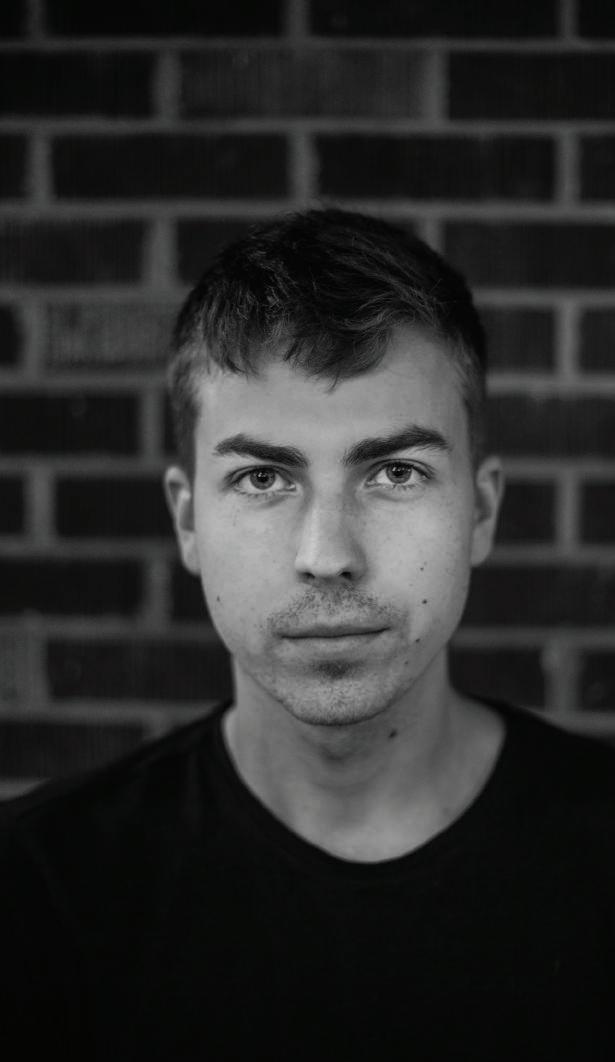
Starting each issue of this magazine is like looking to the top of a mountain summit and wondering how we’ll make the climb. Progress starts slow by scheduling interviews and tackling the more approachable pieces. Co-writing the recipe, “Crisp Sips,” with our web editor Katherine was a good way to put myself in the fall mindset – and that ginger pear cider brought me back from the brink of illness. Get the recipe on page 14.
Our style shoot always kicks off the year with a great bonding experience for the staff. All hands were needed to tackle something as ambitious as “Old Trends, New Tricks,” style editor Dominic Bellotti’s take on retro style made new again on page 32. And in the same vein of old things made
new, on page 21 articles editor Lois Carlisle covered the reinterpretation of the Mann-Simons site, a house that has stood as a touchstone for black culture in Columbia for generations. Lois’ piece and the rest of our features were written in an effort to continue the trend that began last year: the pursuit of longform journalism that places the culture of Columbia in the context of student life.
One of my favorite parts of this job is talking to students like Zoe Dale, whose jewelry line Blind Rabbit is featured in “Artist in Residence” on page 40, and like those whose candid quotes ended up in the “Overheard at Pride” piece on page 47. The interviews I conducted for “The Familiar Feeling,” a piece about the status of Columbia’s queer spaces post-Orlando attack, helped shrink the sense of trepidation I had about approaching such a topic. Speaking with local bar owners and my peers helped make a daunting piece more personal, and it was something I tried to reflect in the piece on page 16.
The first issue of G&B is always a learning experience. With a new staff and new direction there is so much room for things to go wrong, but also so much room for growth, and it’s the latter that I’m most excited for.
EDITOR-IN-CHIEF JAKE MARGLE
6

IIT WAS A DREARY MORNING, but fourth-year geography and marine science student Jory Fleming was anything but gloomy. At the first mention of research, his eyes lit up, and he began to expound on his sea of knowledge (and knowledge of the sea).

“One thing I think that’s pretty interesting is that we know more about Mars than we do about the ocean, in terms of regions mapped and things of that notion,” Fleming said. “The great mysteries of the ocean are still waiting to be unlocked in some sense.”
Jory Fleming
STUDENT RESEARCHER DIVES DEEP INTO UNCHARTED WATERS
BY HALEY SPRANKLE • PHOTOS BY LAUREN NIX • DESIGN BY ELIZABETH ZIGRANG
This mentality, coupled with inspiration from professor Joe Jones’ previous work with ROVs (remotely operated underwater vehicles), led him to seek out research opportunities and put his studies of both geography and marine science into practice.
Fleming’s once base-level interest in ROVs eventually blossomed into a full-blown project with the Congaree National Park, using ROVs to assess aquatic life and map out uncharted grounds. He works with park rangers to take this new information and make it accessible to the public in an attempt to
educate and excite people about about the park.
His community involvement is not just limited to this one project, though. As an active volunteer with Cocky’s Reading Express and as the Education Outreach Coordinator for SEAS (Students Engaged in Aquatic Sciences), Fleming wishes to inspire upcoming generations through creating an informative dialogue and hands-on involvement.
“Science folk can often spend 100 percent of their time on just science,” Fleming said. “I think it should be a more even split between
the science and then communicating your science, engaging other people and getting people generally just interested in what you’re trying to accomplish.”
Full of enthusiasm and drive, Fleming plans to attend graduate school once his time at USC is up. At the end of the day, however, the bright-eyed and optimistic student simply hopes everyone will find fulfilling research for themselves. With that piece of intellectual encouragement as the conversational denouement, he left with a smile and a wave as he was off to go study, well, waves.
8 PROFILES
Ed Madden

COLUMBIA’S FIRST POET LAUREATE TALKS CIVIC ENGAGEMENT, CURIOSITY AND THE FUTURE OF PUBLIC ARTS
BY CAROLINA FAIREY • PHOTOS BY OLIVIA GRIFFIN • DESIGN BY LINDSEY LANE
IF
YOU WERE
ONE of the thousands of rainbow-clad marchers that filled the Main Street in early September, you may have already heard Professor Ed Madden read his poem, “At the corner of Lady and Main.” If you weren’t lucky enough to attend Columbia Pride, the poem is recreated on his website, columbiapoet.org. Just remember: this poem, which weaves soliloquy with conversation, and addresses the complicated relationship Columbia-of-the-present has with Columbia-of-the-past, was written as a celebration. It is best read, not alone in a classroom, but aloud to a broad, joyous crowd.
As Poet Laureate of Columbia, Professor Madden’s official position involves “carrying out activities that engage the public in poetry.” After a year and a half holding these duties, Professor Madden has initiated several major projects designed to bring poetry to the public’s fingertips. “I think a lot,” Professor Madden says, “about how to write in a meaningful way to reach a range of audiences, including those who might never otherwise read or listen to poetry.”
Those living in Columbia last year might remember the short poems, submitted
by local authors of all ages, that rode on the exterior of COMET buses. Local caffeine addicts could also read poetry while they sipped lattes; a series of short poems were printed on coffee sleeves for select cafés. Both initiatives are part of Professor Madden’s vision of a Columbia that treats poetry as an integral part of contemporary culture. “One of my goals as the city’s laureate is to get poems in public places and the literary arts into our daily lives.”
On top of this, Columbia’s Poet Laureate is expected to write poems for special and solemn occasions of statewide significance. Although consistently writing poems worthy of the front page of The State (see “The lesson that night,” one year after the Charleston shooting) seems like a daunting task, Professor Madden approaches it with curiosity and poise. “It’s never really the same city, even after years of living here,” he says. “It’s full of new stories everywhere you turn.” For both budding writers and non-readers, hearing fresh, vital poetry about current events happening in our city is a refreshing reminder of the artistry found in our everyday lives.
9
ALL DOGS GO TO PRISON
BY KELSEY NORRIS • PHOTOS BY JOSH THOMPSON • DESIGN
RACHEL JOHNSON
The rainfall from the previous day had cleared away, leaving the morning sky a brilliant blue and the weather perfect for a walk along Greene Street. Stands of produce from the farmer’s market lined either side, I hadn’t come for them. Rather, like many already gathered along the road, I’d come for the dogs.
The Pet-A-Pup outing, an event where service dogs in training are brought on campus to allow them to learn social skills and give college students a relaxing break from their studies, was sponsored by the Palmetto Animal Assisted Life Ser-
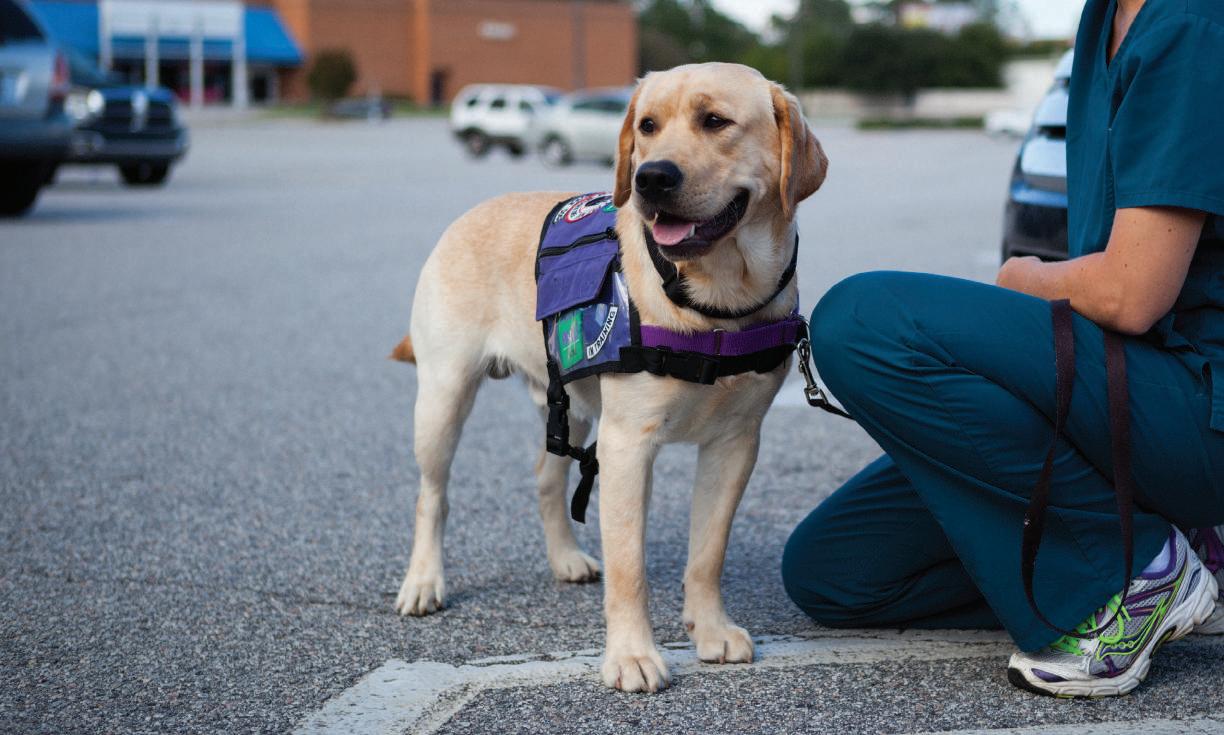
vices, or PAALS. Dedicated to connecting service and assistance dogs with people with physical disabilities and social needs, PAALS is a locally-run program that puts puppies with potential into a two-year-long training program that will ultimately teach them the skills necessary to assist their future owners in their daily lives.
“All our dogs go to prison the first year of their life,” said Maureen Leary, a trainer at PAALS. “They go Monday to Friday right now to Kershaw prison, and are trained by the inmates there. We go out and we train the inmates to train the dogs.”
The following year, the dogs move to the PAALS base to begin advanced training, such as basic tasks like turning on the lights or assisting with laundry, as well as with behaviors surrounding autism and PTSD.
Another key aspect of training is introducing the dogs to new people and places, all the while instilling the importance that the animal must remain calm no matter the situation. Such was the case on Greene Street, where many dogs were wearing their service vests and in training. For the dogs intraining, they could receive adoration from passersby, but only when given
the command to ‘say hello,’ and only so long as they kept their focus on their trainer. Should they become overly excited, a PAALS volunteer would get the dog’s attention and remind them that they were still at work.
“The more we take them out and socialize them, the more they are ready to go out in public eventually,” Leary said.
The five dogs present on Greene Street were certainly excited for the opportunity to interact with the public. One service dog in training, a four-month-old black lab puppy, was particularly excited by the new sights
BY
...OR AT LEAST ALL PAALS DOGS DO. IT’S PART OF AN INTENSE TRAINING PROGRAM FOR SOUTH CAROLINA’S SWEETEST PUBLIC SERVANTS.
10 STUDENT EXPERIENCE
and smells. And the college students were glad to have him and all the other PAALS dogs. The animals were rarely spotted without a small throng of students surrounding them.
For anyone who missed the September Pet-A-Puppy event, fear not:here are many ways to get involved with PAALS. The easiest way is to donate money to the cause (with all donations tax deductible). The money is used to fund training and to assist clients in paying the tuition for team training, a mandatory step in the process of placing of a dog with their owner. But for those who would prefer a more hands-on approach, anyone can fill out an application online and attend a volunteer orientation session. There, they learn different ways to help PAALS, like fostering a dog for a weekend.

Volunteering is particularly easy for USC students
WE HAVE PARENTS
WITH AUTISM
because there is an on-campus partner of the organization, Cocky’s Canine PAALS, which provides a list of available weekly times to volunteer and helps with transportation to certain PAALS events, as well as building a community of like-minded students with similar interests and a passion for service.

“Cocky’s Canine PAALS volunteer at our facility and do animal husbandry … Once Cocky’s Canines are trained doing those things (cleaning the animals and amenities), we try to teach them how to groom the dogs and how to walk the dogs.”
When asked what she found most rewarding about working with PAALS, Leary said, “On a daily basis, just working with the dogs. But the culmination is where you do the team training and the dog gets placed with somebody, and you see the difference it can make in someone’s life, restoring their independence and letting them live a full life. We have parents of children with autism tell us it’s their child’s first time sleeping through the night … It makes an unbelievable difference.”
“
OF CHILDREN
TELL US IT’S THEIR CHILD’S FIRST TIME SLEEPING THROUGH THE NIGHT… IT MAKES AN UNBELIEVABLE DIFFERENCE.”
TO FIND OUT MORE ABOUT PAALS, VISIT WWW.PAALWVS.ORG/ OR CALL (803) 788-7063. TO LEARN MORE ABOUT COCKY’S CANINE PAALS, EMAIL SOPAALS@MAILBOX.SC.EDU OR VISIT THEIR FACEBOOK PAGE, COCKY’S CANINE PAALS AT USC.
11
Fall Bites: Pastries
Columbia’s local food scene has grown exponentially in the past few years, bringing numerous local bakeries with it. We tried some of the best.
 BY KATE STUCKY • PHOTOS BY JOSH THOMPSON • DESIGN BY RACHEL JOHNSON
BY KATE STUCKY • PHOTOS BY JOSH THOMPSON • DESIGN BY RACHEL JOHNSON
RISE GOURMET GOODS & BAKERY
Rise is a cute little cafe that opened this past year and was named Columbia’s Best New Restaurant in 2016. They have a location on Harden Street in Five Points and another in Olympia Mills. They’re known for having a wide selection of menu items ranging from lunch and dinner options to sweets and pastries.
The pastry that caught my eye more than anything was their candied apple galette. A galette


CRUST BAKEHOUSE
Crust sits at the intersection of Rosewood and South Woodrow. It’s an easy corner to miss, but one you won’t want to. The shop feels artistinal. Every day, they post a menu of the wide selection of breads on their Facebook page. They have a little something for everyone, including homemade treats for your dogs.
I tried the cherry pecan scone, which tasted rich
and tart. I also got the caramel pecan pound cake, one of their signature dishes and a best-seller. It was the perfect combination of sweet caramel and bourbon glaze undercut by the warm nuttiness of the pecans.
Their scones cost $2.69 apiece, and for those interested in their artisan bread, their loaves go for $6 and are finished baking around 10 every morning.
is a round, flat, crusted cake with a fruity or savory filling. Rise lets their apple filling cook to develop the bold flavors. This method gives it the right amount of sweet without the common caramel or cinnamon apple taste.
All of their baked goods and pastries range between $3 and $6. Although their pastry case selection may not have as much variety as some, they put up a good competition with taste.

12 FOOD FIGHT
SILVER SPOON BAKE SHOP
What was once an old house on Devine Street is now a small bakery. From the second you walk through the doors, the scent of delicious baking washes over you. On Wednesdays, they make cinnamon rolls, and on Fridays, they have specialty croissants. Silver Spoon also serves coffee that is locally roasted at Turtle Creek Coffee.
In 2014, Silver Spoon Bake Shop won Columbia’s Best Biscuit, so, of course, I had to try one. I was feeling pretty adven-
turous and tried the black pepper and pimento cheese flavor. The pepper gave the perfect little kick to the pimento cheese. I also tried the bacon and cheddar. Bacon lovers around Columbia should flock to this biscuit.
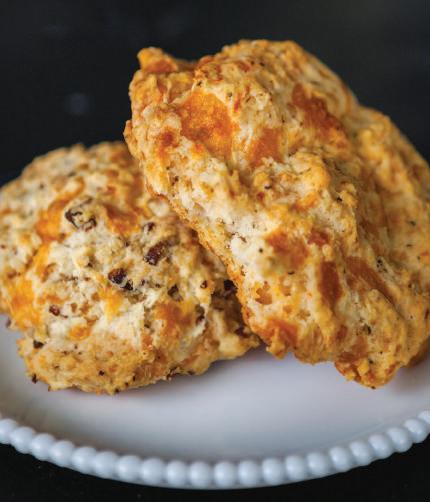
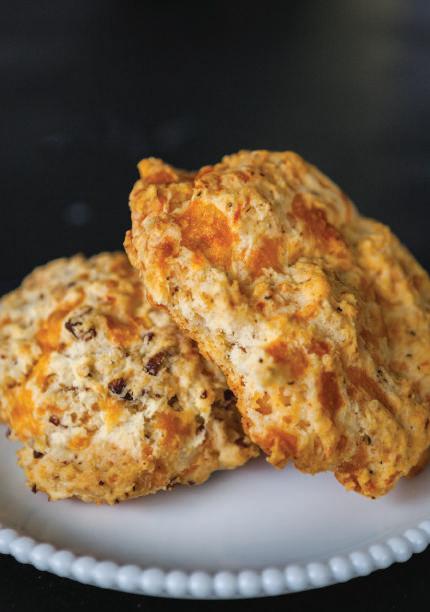
All of their biscuits go for $1.75 each while the rest of their sweets and pastries go for between $2 and $3. The biscuits are scrumptious and filling, especially for how little they cost.
ALLY & ELOISE BAKERY
Ally is the owner; Eloise is her spunky French Bulldog. The bakery was one of the first in the area when they opened on Forest Drive more than four years ago. Their signature items are brightly colored macaroons and dainty baby cakes. They also sell cake pops and gourmet cookies.

Each of the macaroons is dyed vivid hues with different colored fillings for different flavors. The baby
cakes are petit pound cakes glazed with rich buttercream. Although their current store is farther away, their new location on Main Street is right near the bustle of downtown. It’s within perfect walking distance for anyone living on campus who wants to satisfy their sweet tooth. Their macaroons are $2 each and the cookies are $1.50 each.
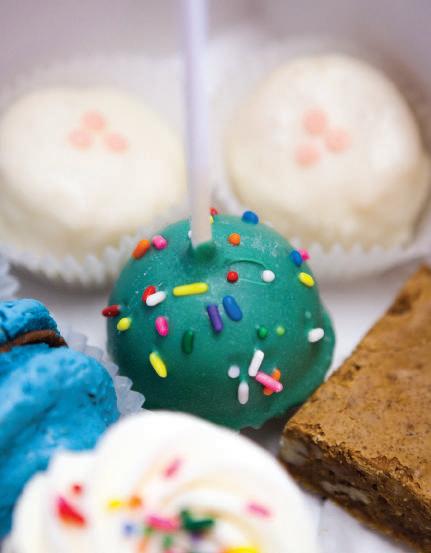
13
Crisp Sips: Fall Flavors
Love yourself! Toss that PSL in the trash and run in the other direction. You deserve better. There’s more to fall than synthetic pumpkin flavoring. Here are two of our favorites.
BY JAKE MARLE & KATHERINE FINNEY • PHOTO BY SAMANTHA MORRIS • DESIGN BY ASHLYN MURPHY
CRANBERRY SWEET TEA
Because we all know fall in South Carolina is just summer in disguise, why not chill with a seasonal sweet tea? Cranberries and black tea make this the perfect partner for any meal. Plus, this recipe can easily be doubled for a tailgate crowd.
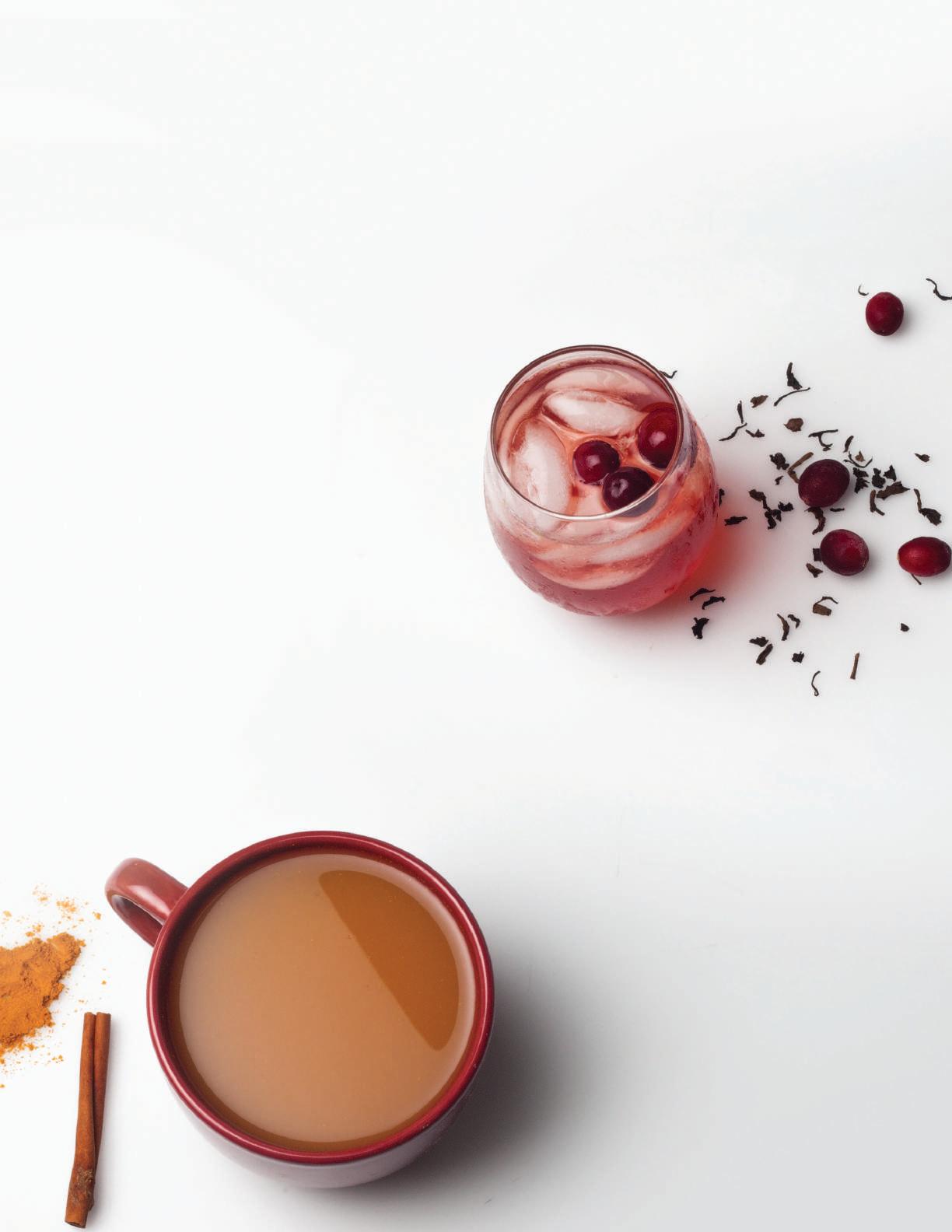
8 cups water
2 bags black tea
½ cup sugar
Bring 4 cups of water to a boil. Remove from heat and steep black tea bags for 3 to 5 minutes. Add sugar, then remaining water.
CRANBERRY SYRUP
8 oz. cranberries
½ cup sugar
½ cup water
Add cranberries, water and sugar to a saucepan. Bring to a rolling boil for 5 minutes. Reduce heat and let simmer for 10 minutes. Once the syrup has thickened, put mixture in a blender. Blend, adding water until it runs easily from a spoon. Run syrup through a fine mesh strainer, and add to tea to taste.
GINGER PEAR CIDER
This cider isn’t just tasty, it’s packed with spices to keep you well through the heart of flu season. Turmeric is an immune-boosting miracle and ginger will help to ease that sinus pressure you’ve been fighting all week. We’ll have you better in no time!
4 cups unfiltered apple juice
2 cups pear juice
3 slices fresh ginger root
2 cloves
1 cinnamon stick
1 tsp turmeric
½ tsp nutmeg
Add all the ingredients to a medium-sized pot and bring to a simmer. Let sit for 15 minutes. Strain and serve hot.
BLACK TEA
14 RECIPE
A SELECTION FROM THE LETTERED OLIVE
CONVINCE ME
BY JENNA SCHIFERL
Soft purple kisses
Decorate her forearms
Blood vessels lie sleeping
Beneath translucent paper skin
The unforgiving bruise that remains
Light oozes
From the expensive lampshade
That resides in the corner
It observes
Syllables roll off Her limp tongue, A mollusk.
They fall to the floor With a dull thud
The numb pedantic rhythm Of vowel and consonant
Blood runs
In rivulets down her cheek
THE
UNDERGRADUATE
INTERESTED IN READING ITS ENTRIES OR SUBMITTING WORK SHOULD VISIT THEIR WEBSITE, LETTEREDOLIVEUSC.WORDPRESS.COM
LETTERED OLIVE IS THE UNIVERSITY OF SOUTH CAROLINA’S
CREATIVE JOURNAL. STUDENTS
15 FEATURED POETRY
THAT FAMILIAR FEELING
AMONG THE NEON LIGHTS AND APPROPRIATELY LOUD RADIO REMIXES FILLING THE CAPITAL CLUB, THERE’S A FAMILIAR FEELING. PATRONS SIP DRINKS AND QUIET CONVERSATIONS SPREAD FROM THE BAR TO THE BACKROOM. IT’S A FEELING I’VE FELT IN EVERY GAY BAR IN COLUMBIA, WHETHER IT’S PT’S 1109 OR THE L WORD. HOWEVER, THERE IS SOMETHING DIFFERENT ABOUT THE AIR IN EACH AS OF LATE. THE SAME SOCIABILITY IS THERE, BUT THE ATTACK ON THE QUEER COMMUNITY THAT OCCURRED ON JUNE 12 HAS LEFT A SLIGHT TENSION IN THE ATMOSPHERE.
 BY JAKE MARGLE • PHOTOS BY BRENNAN BOOKER
DESIGN BY RACHEL JOHNSON & CHARLOTTE PRICE
ILLUSTRATION BY ALEX RUSNAK
BY JAKE MARGLE • PHOTOS BY BRENNAN BOOKER
DESIGN BY RACHEL JOHNSON & CHARLOTTE PRICE
ILLUSTRATION BY ALEX RUSNAK
16 FEATURE
THREE MONTHS AGO, 49 people were killed at Pulse, a gay nightclub in Orlando, Fla., in what became the worst mass shooting the U.S. has ever seen. In the wake of the attack, think pieces and news articles flooded our channels and newsstands, asking us what would become of the queer community.
It’s 6 p.m. and the sunlight streaming in through the curtains of The Capital Club is painting the bar in a curious light as it mixes with the neon, and that same question is on my mind.
“Back in the early years, those windows were boarded up,” says Bill Skipper, the original owner of The Capital Club. The venerable bar has stood on Gervais Street for 36 years, the first gay bar in the state. “There was a time when you couldn’t park out front because you would get your car egged.”
The Capital Club is an institution in its own right, and a critical piece in the queer spaces and places of Columbia. The role of those spaces — gay bars — has become murky in the past few years as the US moves towards a more liberal stance on homosexuality.
As of late 2015, 54 percent of American Christians believe homosexuality should be accepted, compared to 76 percent for non-Christian faiths and 83 percent for non-religious people, according to the Pew Research Center. As majority opinions change, one might think that the queer community feels at home in bars in Five Points or the Vista, just as they do in PT’s or The Capital Club, but Pulse has shown us that this isn’t true.
After the massacre at Pulse, I expected a fallout amongst the gay bars of Columbia. Such a vicious attack — one with omnipresent coverage of the carnage done by the gunman, Omar
Mateen — would have surely instilled a dominating sense of fear into our small Columbia community.
“We were concerned that fear would keep people home, and it did a little bit,” Garry Dollahite, co-owner of The Capital Club says. “People were afraid to come to a gay bar.” Dollahite co-owns the bar with Filip Risteski.

Dollahite noticed that in the two weeks following the attack, considerably fewer people were in attendance at the bar. The importance of our gay bars as forums and sanctuaries was negated by the vacancy that occurred after Pulse.
“It is our responsibility to provide a safe haven for people to come be who they are and what they want to be under safe conditions,” Dollahite says. Not only that, but in the ‘60s and ‘70s, gay bars were very much political breeding grounds. They were spaces for conversations and the development of queer culture, which is why Pulse came as such a shock.
“My first reaction was to subside fear,” Dollahite says. “People start asking, ‘Oh, what if that happened here?’ You just can’t live that way. What we wanted to instill in people is that we’re gon-
na make things as safe as possible. Can we guarantee that 100 percent? No. No one can, but we can take measures to be as safe as possible and to provide the proper environment.”
If you enter The Capital Club with a backpack or anything of similar size, it will be searched. They’ve beefed up their camera system to make sure all areas of the bar have coverage, and it’s not something they were happy about doing. Dollahite doesn’t want increased security and vigilance to contribute to any remaining sense of fear, but rather to ensure that these spaces, our spaces, remain safe and standing.
A night at The Capital Club or PT’s is illustrative of the fear that has subsided, and for our bars, there is no other choice. Our queer spaces are the places that facilitate us, like an artist’s studio. It was surprising to see the crowds back in their usual numbers after a space we created for ourselves was so publicly violated, but the only solution to an act that was intended to shut us out is to rally and not let fear take over.
It’s something Skipper has seen before. In the early ‘80s, he was inside a gay bar in Wilmington, North Carolina, when a group of men backed their trucks up to the front of the establishment and opened fire with semi-automatic weapons.
The local judge dismissed the case because the establishment that Skipper and his friends were attacked in was a queer space, but it’s a lesson he’s kept with him for years for when enemies of the LGBTQ community remind of us their presence.
“There’s two ways to deal with problems,” Skipper says. “It’s called fight or flight, and I’ve already tried flight, and it doesn’t work.”
In the wake of violence, the approach should involve more activism and more outspokenness, not a recoiling of voices. Instances of violence against the LGBTQ community almost always come at times of progress, a retaliation of sorts.
With retaliation comes a response, however, and the vibrancy that has filled these spaces again is an indication of the only weapon we possess at work.
“This is a historic place,” Skipper says. “I’m very emotional about this place and I love it.”
“OUR QUEER SPACES ARE THE PLACES THAT FACILITATE US, LIKE AN ARTIST’S STUDIO.”
17
“I WAS HORRIFIED, but I wasn’t surprised,” Caleb Coker says in reference to the morning they woke up to news about Orlando.
Coker, 24, is well known around Columbia for their drag personalities. Most notably, Ebony Would, and more recently, Sister Anna Konda. A large part of Coker’s success and reputation is built on their visibility and outspokenness, and their prominence in the queer community means that they’re very receptive to the attitudes and perceptions of those around them.
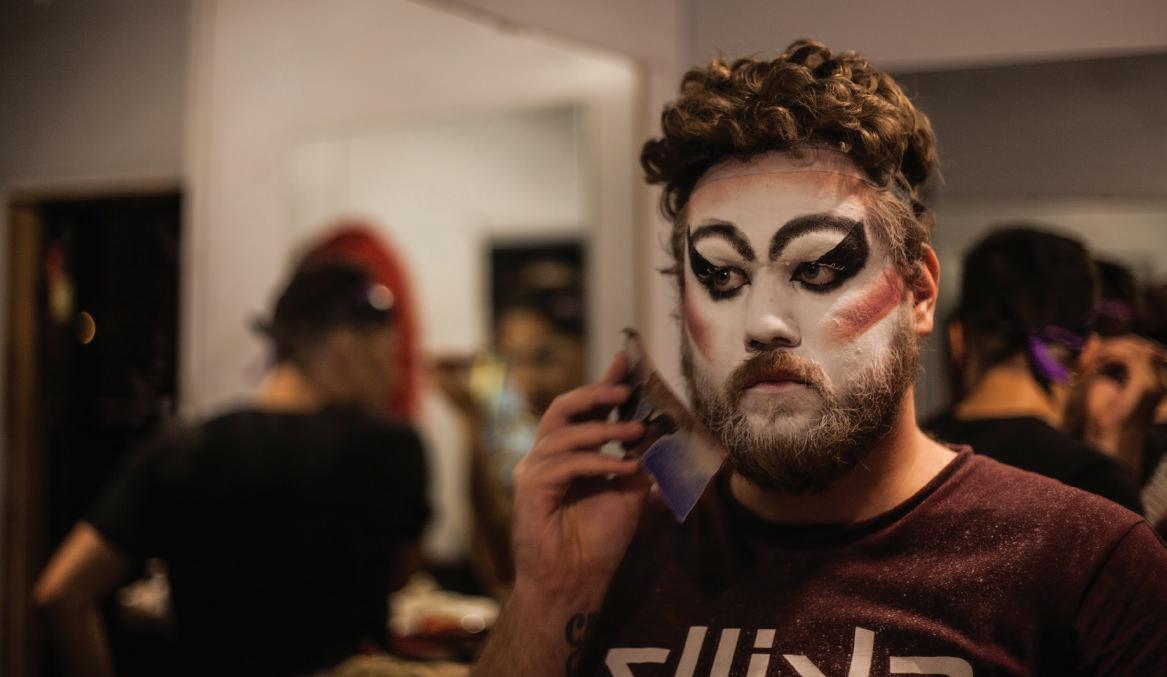
“I guess what made [Pulse] more real for us was that a lot of us knew people that worked at Pulse,” Coker says. “Latrice Royale was scheduled there for the next week. We all kind of knew queens that worked there or had been there themselves. I had a close friend who had just moved from Orlando to here.”
Coker works predominately at PT’s, and in the first week after the Orlan-
do attack they noticed an ambivalence toward the act and air surrounding it.
“The next time I went out was a Tuesday, which was also when the next drag show was. It was like no one was reacting to it,” Coker says. “No one seemed upset and I almost think that was just them coping with it, like ignoring it.”
In the wake of Orlando and the months since, I expected to see two approaches to coping: an overwhelming sense of love and compassion exchanged between LGBTQ members and allies or a dismal sense of fear that would leave our communal spaces vacant. And I saw both in those first days, but what I was anxious to see was the behavior expressed in the weeks, and in turn, months after the attack.
This is what Coker seems to be describing: this selfaware ambivalence that seems to be the only option for a community like ours in a time like this.
“As far as healing in the community, it has to be a personal thing. You have to find a way to cope in a way that works for you,” Coker says. They turned to community outreach to help process their emotions. “Whenever I don’t know what to do or how to fix things, I try to fix things in other people’s lives.”
As far as a widespread solution goes to combatting the fear that the Pulse attack spread, the question, “Are those in the queer community activists now?” comes to mind. We’ve always had a greater sense of representation placed on each of our shoulders as being part of what society calls a “lifestyle,” but Pulse may bring a bigger duty to us all.
“We don’t have a model for this. We don’t know what to do, and I think that it’s scaring a lot of people,” Coker says. “I’m almost thinking of a herd of buffalo or bison that, when they’re attacked, they huddle around the young and the
18
“BEING A DRAG QUEEN MAKES YOU THE BIGGEST TARGET IN THE ROOM.”
sick. They tighten ranks, and I feel like that’s what the queer community is doing. We’re closing ranks now and pulling closer.”
In August, Slate published an article asking if drag queens should be activists now. This question of activism is more pertinent for those in the spotlight, specifically drag queens.
“I’ve known this for years, that being a drag queen makes you the biggest target in the room, and that’s physically,” Coker says. “I’m 6’5” in heels, with hair I’m 6’7”, and I’m also shiny and I show up more. I’ve always understood that makes me more of a target, and I used to go out with my friends in drag because I would always think, if anyone is going to attack anyone, it’s going to be me. It won’t be one of them.”
Coker always knew this when they ventured out of the gay bars and into straight spaces, but Pulse has forced them to recalibrate where their, and everyone else’s, safety lies.
“I think every drag queen knows that going out is dangerous. Going out in straight spaces is dangerous because they’re not exposed to that as often. You can be met with a lot of transphobia and a lot of homophobia,” they say. “Now it feels like, even in spaces that we create, there’s still a chance that we could be killed.”
The real problem in Columbia post-Pulse is that we are now forced to evaluate our safety not only outside of these havens made for us, but also within them. It would always be the people of the queer community bearing the brunt of an attack like this, but now it seems as if we have nowhere to go.
KAITLIN MCCLAMROCK has quite a duty as president of IRIS, or Individuals Respecting Identities and Sexualities. As the student leader of an organization that tasks itself with representing the LGBTQ community at the University of South Carolina, she must also ensure that those people do in fact have somewhere to go.
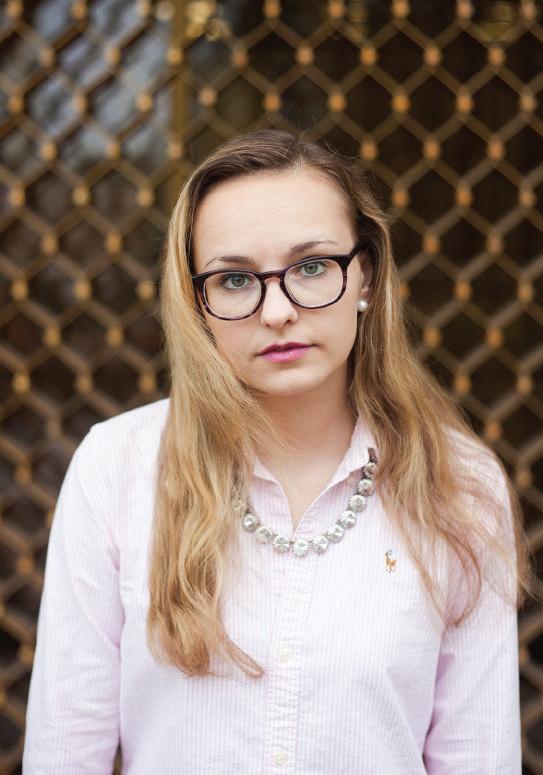
“After Pulse, something shifted, and all of the sudden we needed to connect people with services and we needed to be there to fill this kind of gap,” McClamrock says. “In a way, we had to become more of a safe space.”
IRIS is first and foremost
a safe space, and always has been, but their campus-wide image seems to lie in the entertainment they back for students. Mr. and Mrs. Gaymecock in the fall and The Birdcage in the spring, drag pageants and shows respectively, contribute to the event-centric perceptions of IRIS.
In the days after Pulse, McClamrock and others at IRIS made a push to show their members and students at USC that their support extended far beyond weekly discussions. IRIS contacted the counseling center at the university to open up counseling services to students,
regardless of whether they were enrolled in summer classes, without charge.
When school resumed and IRIS began their first meeting, there were no admittances of fear or dread of returning to school or the spaces these members once frequented. Instead, students shared their first experiences with a gay bar. In a place open to discussion about anxiety and concern, the conversation focused on the positivity of the places in question. This resurgence of fervor highlighted the importance of activism as one of our only defenses.
“If any change can come by us actually getting out there and pushing the boundaries and literally rioting if we have to, then I’m willing to do it,” McClamrock says. “I want our people to be safe. I want everyone to be safe, and activism is one of the only things that does work. We’re trying desperately to get any kind of policies pushed through. Even something as small as the Safe Zone Ally legislation on campus for student government officials to go through safe zone training to combat some of the misunderstandings or internalized homophobia that may be happening.”
McClamrock hopes that if anything good can come from the attack in Orlando, it’s that people might not be so inclined to brush off casual insults, microagressions and trans- or homophobia. Linking these everyday acts of antagonism with the very real possibility of violence may prevent something like Orlando from happening again.
“As it stands now, we’re not protected,” McClamrock says. “Now there’s more of an emphasis to act.”
“AS IT STANDS NOW, WE’RE NOT PROTECTED .”
19
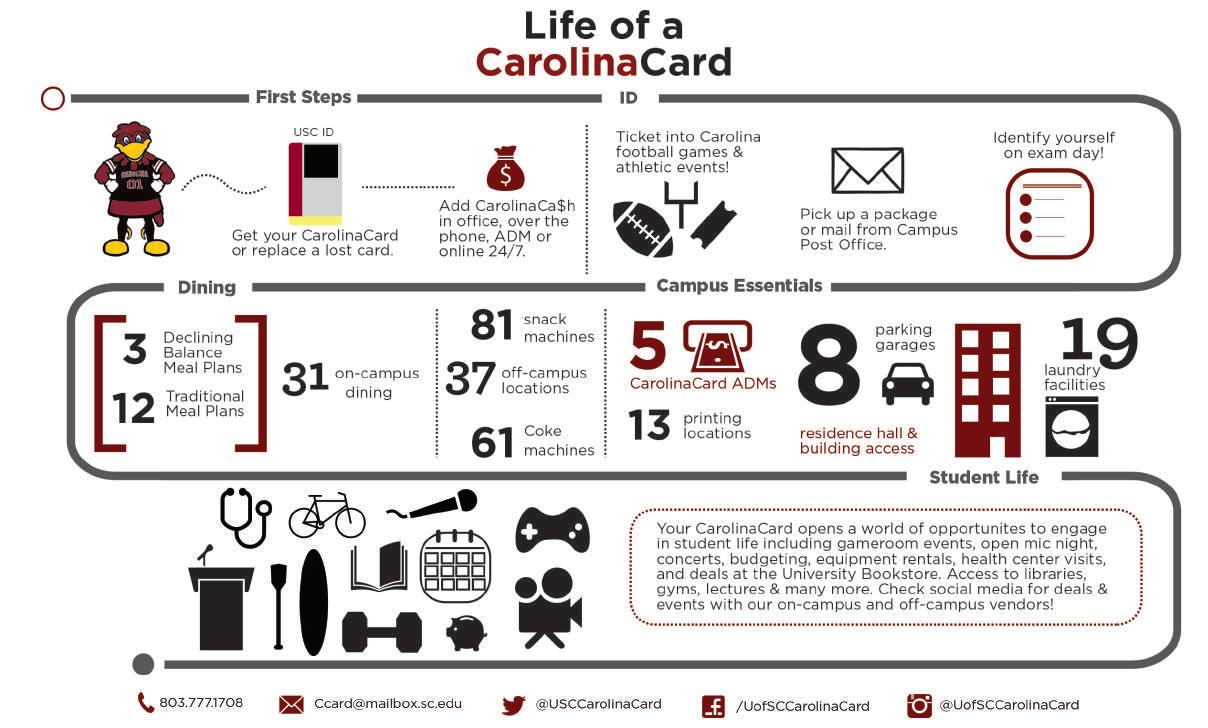



































































AS YET UNTOLD

THE REINTERPRETATION OF THE MANN-SIMONS SITE
 BY LOIS CARLISLE
BY LOIS CARLISLE
A LOADED PISTOL. A CONDOM WRAPPER. TWO-HUNDRED YEARS’ WORTH OF BOTTLE CAPS. SKIN LIGHTENER. THREE PET BURIALS. THE INTACT BASE OF AN INCANDESCENT LIGHTBULB. CHILDREN’S TOYS. BONES. THE RELICS OF PAST LIVES DON’T JUST REMOVE THEMSELVES FROM THE GROUND. THAT’S JAKOB CROCKETT’S JOB.
• PHOTOS BY JOSH THOMPSON • DESIGN BY RACHEL JOHNSON
21 FEATURE
OVER THE LAST 10 YEARS, HISTORIC COLUMBIA, A NONPROFIT PRESERVATIONIST ORGANIZATION, HAS WORKED TO RECONSTRUCT THE STORY OF ONE OF COLUMBIA’S MOST PROMINENT AFRICAN-AMERICAN FAMILIES: THE MANN-SIMONS SITE. CROCKETT AND HIS EVER-CHANGING TEAM OF ARCHAEOLOGISTS HAVE TILLED THE SOIL OF THIS HISTORIC HOME, LOOKING FOR THE ANSWER TO A SINGLE QUESTION: WHAT HAPPENED HERE?

As it turns out, a great deal. At the corner of Marion and Richland streets in downtown Columbia stands the last surviving home owned by free African-Americans in the city. This land, this house and the foundations unearthed by Crockett shepherded generations of African-Americans through the Civil War, Reconstruction, Jim Crow and the desegregation movement of the 1960s.
The land belonged originally to two former slaves from Charleston, Celia Mann and her husband, Ben Delane. Celia was born in 1799 and migrated to the midlands by the late 1830s. Ben, after purchasing his freedom, purchased Celia and married her. Celia was a midwife and well-liked member of the communi-
ty. Her obituary describes her as “well-respected,” an unusual descriptor for a black woman in the pre-war South. Celia and Ben had a daughter, Agnes, and it was Agnes who built the home now operated as a museum by Historic Columbia.
How could a woman like Celia, living in a deeply divided, segregationist climate, make a name for herself? The recent reinterpretation of the Mann-Simons Site aims to answer this exact question.
When I arrive at the Mann-Simons Site — a home that almost didn’t survive the last century — rain is pouring and the lights inside, already low, flicker as thunder rolls. There are boxes stacked high along the walls and display stands sit empty. Spotlights illuminate vacant
pedestals. It looks as if the family is moving back in after a long time away. The museum is set to reopen to the public in a little less than a week from now at the 38th annual Jubilee.
The decade-long reinterpretation has finally come to fruition in the panels and artifacts and screens of the house museum. The purpose of a museum is to tell stories we have never heard and ones that we need to hear again and again. They create a sacred space for the maintenance of narrative and shoulder the burden of truth. Historic Columbia’s reinterpretation of the story of Mann-Simons places the family’s community role at the forefront.
I’m reading the panel about a churchyard duel when a man emerges from
the basement and scares me half to death.
It’s John Sherrer, director of cultural resources at Historic Columbia and possessor of encyclopedic historical knowledge about Columbia. This house is Sherrer’s responsibility. He invites me into the front room where there’s a folding table and countless power tool cords. He brushes the dust from his chair before we sit down. Two firetrucks fly by outside and thunder rolls.
Back in 1970, Sherrer tells me, when the house was threatened by the Columbia Housing Authority, the African-American community rallied for preservation. During that time, the Mann-Simons site became a cultural hub, deeply interwoven with the African-American historical
22
narrative of the city.
“You can’t have a history of Columbia without an African-American history,” he says.
Massive, white metal frames tower over the site in a profound and sheltering way. The ghost structures are meant to give a greater sense of the community that occupies the site, detailing buildings that were “lost” over time. From the front window where we sit, you could reach out and touch the frame of the former corner store next door. Three more structures line up on the edge of what is now a parking lot out back and three more ghost forms tessellate themselves in the remaining spaces. What visitors have found difficult to comprehend in the past, Sherrer tells me, is the close proximity of these lost buildings to the main house.
It was Crockett’s research that helped recreate the spatial configuration of this small, ghostly neighborhood.
“The types of artifacts here ran the gambit honestly from the most mundane to the most intriguing,” Sherrer says. “Glass, nails, wood, brick — you find that a lot, but you don’t often find pet burials, a loaded hand gun from the turn of the century … skin lightener, cosmetic products. You don’t find a condom case. Just human stuff that’s often discarded.”
The overarching theme, stressed in the new exhibit, is the humanity of the site. The reinterpretation emphasized again and again the roles of individuals who lived on the land. Who worked, suffered, found strength and strived here. The endeavor is more than a load of old bones — it’s a revealing insight into the compassion of the community at large.
The research Crockett did has allowed Historic Columbia to trace how the family acquired new technology over the years.
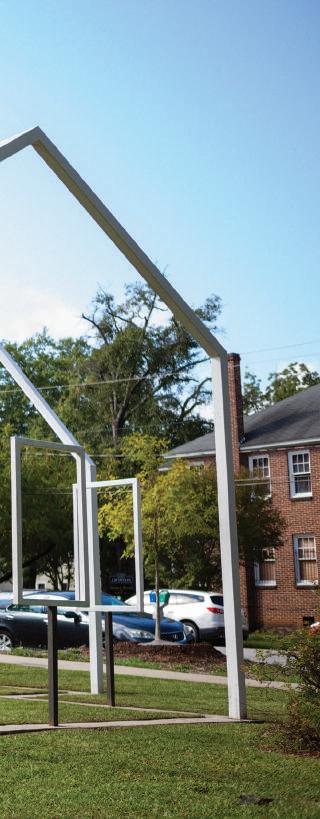
“That speaks volumes to the family, but also really helps to dispel often entrenched within the public assumptions of race or class,” Sherrer says. “You automatically think because this family lives in a house this size or in this neighbor-
hood or because the family was maybe middle class or African-American or whatever then this. Well, no, it makes the story much, much more complex. The community becomes more nuanced, and it’s a human story.”
That sums up the mission of the Mann-Simons Site: to tell a story — many stories — that continues to this day. Mann-Simons combats the arcane stereotype that museums are shrines to the past. Instead, the new exhibit places the house and its uses into the context of the present. What’s more, Mann-Simons hosts the annual festival of black history and culture in Columbia: the Jubilee. The Jubilee celebrates that narrative with performances by musicians, dancers and historical interpreters. The day-long event draws massive crowds every year.
One short week after I toured the unfinished museum, the Jubilee gets underway. Hundreds of people gather on the lawn, in the street and on the porch listening to music, buying crafts and swapping stories. It’s this community that the house was made to foster. From my vantage point on the back porch, I watch old friends catch up.
“A lot of people come to Jubilee, and we won’t see
them again until the next year,” Sherrer says. “That’s something we really want to change. The Mann-Simons Site was a place for groups to get together.”
There’s a community space in the basement that Historic Columbia hopes groups will use in order to continue the home’s legacy.
“It’s a conversation starter on things that were important historically, but also things that are important now. Let’s talk about class. Let’s talk about race. Let’s talk about issues in our community. Violence. Let’s talk about literacy, land use, what gets preserved and what doesn’t get preserved,” Sharer says.
Upstairs, visitors filter in and out of the museum with the same comfort and ease as they would their own homes. From one of the exhibit’s four interactive screens, the choir sings a rendition of “The Train is Bound For Glory.” One of the docents leans over and tells me the whole crew was singing it last night while they were putting the final touches in place.
As it should be, I thought, a house full of song.
The past is something that’s already happened. History is the stories we tell to keep it alive. Mann-Simons has a lot more singing to do.
“ 23
LET’S TALK ABOUT CLASS. LET’S TALK ABOUT RACE. LET’S TALK ABOUT ISSUES IN OUR COMMUNITY. VIOLENCE.”
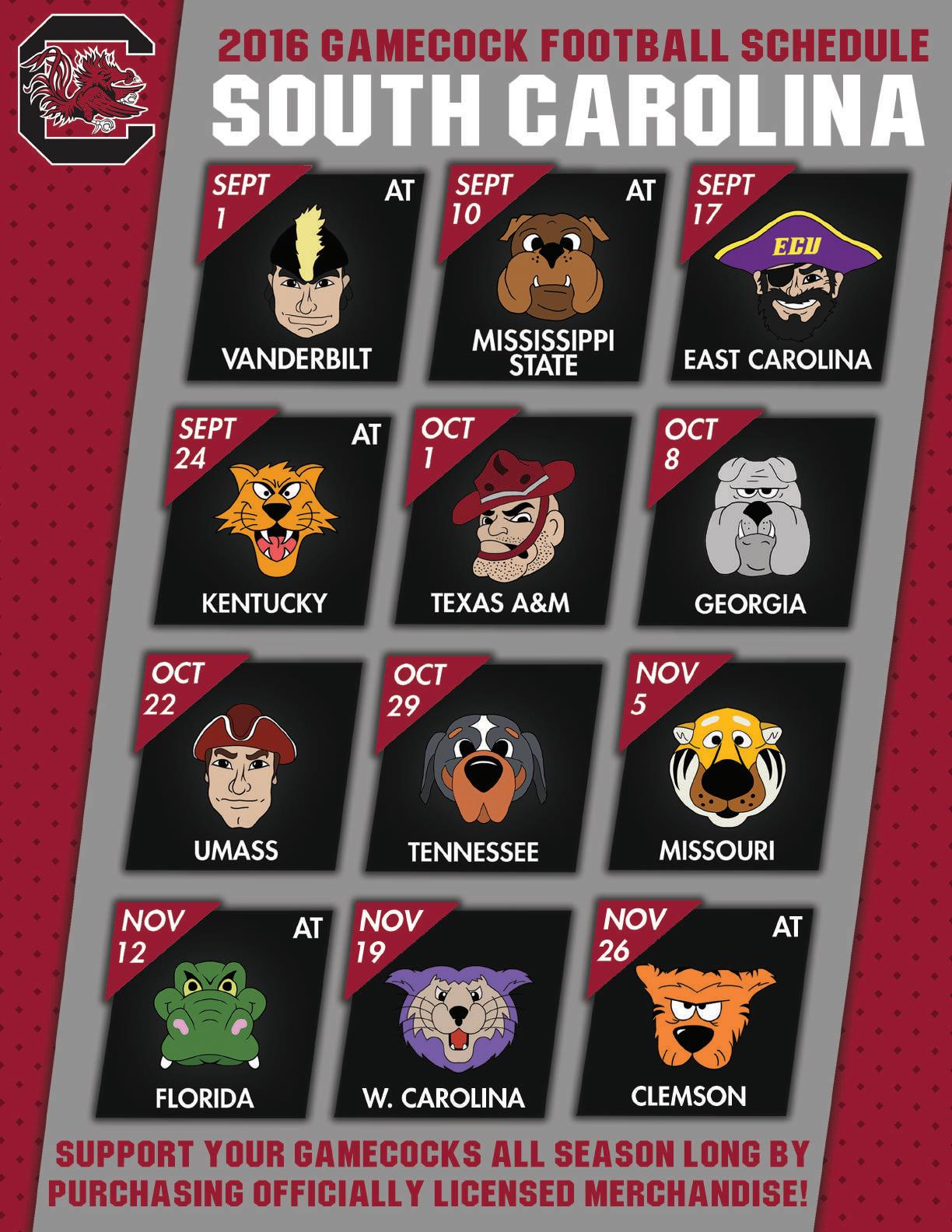 BY BEN CRAWFORD • PHOTOS BY JOSH THOMPSON • DESIGN BY CHARLOTTE PRICE
BY BEN CRAWFORD • PHOTOS BY JOSH THOMPSON • DESIGN BY CHARLOTTE PRICE
DO YOU, LIKE ME, often find yourself trapped in your own head? Do you begin one thought and, before you know it, find yourself above the Earth somewhere, in high-altitude theoretical space?
If you do, you should know that a consistent way to return to reality exists. It is called “grounding.”
To “ground,” you must focus on your immediate surroundings. First, you must sit down. Somewhere comfortable is preferable, but not altogether necessary. You must feel the feet in your
socks. You must smell the air and try to discern what you are smelling.
You must breathe in and you must breathe out.
This serves to enmesh you in your present state. If it works, you are no longer stuck in your own inner monologue. You are here. You are sitting. You are in the real world.
Here’s the thing, though: “Grounding” no longer works — at least, not for me. Because every time I sit down and try to feel the feet in my socks, a blinking,
red-tinged shriek blossoms forward from the back of my skull:
Donald Trump is the republican nominee for president.

The words feel like a curse. It suggests that somewhere, a crucial thread that helped govern the fabric of history has disintegrated. The American capacity for anger finally overpowered its capacity for thought, and now we are here. Donald Trump is the Republican nominee for president. The sickening, cackling, under-brain that governs our worst instincts has won out
and brought Trump into the world.
There is still time left.
Those of us who haven’t been captured by his personality-cult and who can see him for who he is are doing our best to stop him from his ascent to the presidency. However, not everybody who sees him understands what he really is. They comfort themselves in their support or silent complicity because they can force themselves to believe a number of things — that Hillary Clinton is
25 FEATURE
equally wretched, or that he wouldn’t be so bad as president if he surrounded himself with the right people.
That, maybe, he can learn.
By the time I find the right activity room in Russell House, it’s already crowded. Dozens of people — overwhelmingly white, more male than not — are attending the first USC College Republican gathering of the fall semester. Every one of the 60 or so chairs is filled. People are scrambling for wall-space to lean on. The style is primarily — though not exclusively — the ubiquitous Easter-egg-colored Greek T-shirts paired with shorts of varying lengths.
I scan the crowd for Trump paraphernalia and come up with nothing.
A voice from the front quiets the crowd: “So, first of all, let me just say, we’re in here like sardines, so I apologize.”
The voice is Nick Pasternak’s, the College Republican’s Chairman from Greenville. His demeanor is one of a generous and thoughtful person. After a few introductions, he tells the crowd that he worked on the Marco Rubio primary campaign.
Remember Rubio? Some months back, that also-generous, also-thoughtful U.S. junior senator from Florida
was chewed up and spit out, half-alive and covered in saliva, on a nationally televised debate stage. And, even as he tried to position himself as the future of a party that could win elections, the Republican electorate did not side with him. They sided with the chewer.
Soon enough, and after a few more minutes of introductory speaking, Hope Walker — tonight’s guest speaker and executive director of the South Carolina Republican Party — takes over for a while.
She says the following to a crowd of young, thinking people, who represent the Republican party’s future:
“Obviously Donald Trump wasn’t my first choice,” she says. “But I’m a Republican. I’m a conservative. And anybody’s better than Hillary Clinton. And I think if you’re in this room, we can all agree on that.”
This is the moment. I wait for someone in the room to process the insult they have just been dealt: That because of their shared Republican values, they are obliged to ignore those values in order to hand over the power of a nation to a bag of snakes in human form. I wait for someone to spit, throw salt over one shoulder and walk out cleansed of the implication.
And nothing happens. Walker, uninterrupted, continues talking for a while. There is a short Q&A session afterward. When Trump is mentioned, it is in passing and without dissent or outrage. Half an hour later, the meeting ends, and everyone leaves.
A week later, I asked Pasternak about what position his organization would take on Trump. Other College Republican organizations, like Harvard’s, have taken a public stance against him. What is the College Republicans’ stance?

It is worth quoting him in full: “Our group is diverse in its opinions in every way,” he said. “We have members who are very anti-Trump.
We also have guys who love Trump. I’m not going to express my personal opinion either way, because I think my job is to be a fair arbiter of the entire group. But I’m providing a space for everyone on both sides to talk it out on both sides — people who hate him and people who love him. But, like I said, we’re not trying to divide everybody.”
I am sympathetic with this argument and with the sentiment that underlies it. It is similar to the argument that Paul Ryan, one of the most powerful people in the world, makes when he is questioned about his continual silence about his party’s nominee. It is far, far easier to moderate a discussion than to lead a band of different-minded people to even an obvious truth.
It is, however, an argument made with inadequate premises. The party is already divided. The ideological civil war between the Cruz-ites, the Trump-ites and everyone else is being fought as we speak. Not talking serves the side of Trump and those who revere him.
If those Republicans who are able to recognize Trump’s full horror band up to defeat him — or, at least, refuse to vote for him — it wouldn’t even be a contest. Republicans would deal with four years under a Democrat and come back far stronger
“A VOTE FOR DONALD TRUMP IS NOT SIMPLY A MISTAKE – IT IS AN ACT OF MORAL DISASTER.”
26
in 2018 and 2020 with fresh Clinton scandals to use as potent weapons.
But, despite everything, the presidential race continues to be a contest. A recent New York Times/CBS poll had Trump and Clinton in a dead heat at 42 percent when third-party candidates are included. There is no wiggle room. It is the duty of every Republican worth the name to stand up and say that this person does not represent him or her and that voting for him would be a mistake. Until they do, I will continue to make the following case.
It is no use trying to attack Trump’s policy proposals. They are fantasies immune to logic and argument. They mean different things to different people: For some, his wall is real. For others, his wall is a metaphor. Any idea that might disqualify him in their eyes,
they chalk up to “Trump being Trump.” Any of his ideas that they endorse become, to them, what Trump actually believes.
So, instead of his ideas, we must examine the man who dreams up these fantasies and seeds them in the minds of millions of people. The process is easier than expected. Anyone who has seen him speak for a continuous 30 seconds on television knows what Donald Trump is. And it’s not that he’s just a charlatan or a racist or any of the other epithets that he’s been given in the past year. (Although, of course, he is many of those things.)
It is sadder than that: He is what happens when a human being fails.
If a good person is measured by the ability and desire to connect with and help other people, a failed person is someone who has lost the instinct toward goodness. In this sense, Trump’s failure as a human
being is total and suffocating. Whatever conscious or capacity for empathy he may have had has been evacuated, shot out of an airlock into the void.
All that’s left is the need for things that have never sated him or anyone else: money and easy love. He is addicted to them and does not have the capacity to break himself free from them. He serves as a warning to the young: If you are not careful, this is who you might become.
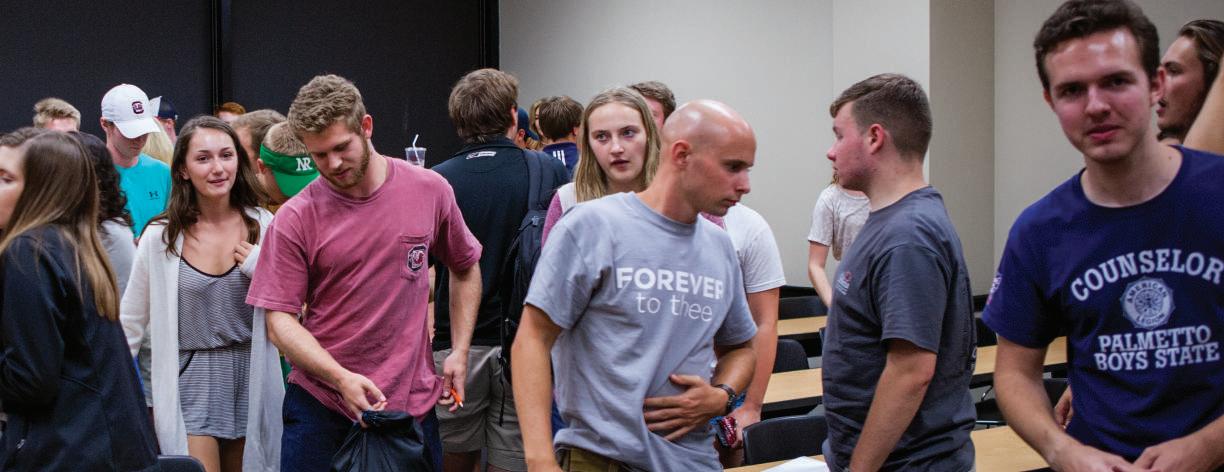
Trump may soon become one of the most powerful people in the world and will always be a man in a cage.
But for those Republicans who despise him for what he has done to the party, take heart: Trump is not a Republican. He isn’t anything. He is a nihilist. To be political by any measure, there has to first be an instinct to care about how the world is run outside of yourself. Trump does not care
about any part of the world that does not benefit him. If he believed that it would get him the most acclaim from the most people, he would act on his made-up-on-thespot propositions — that women should be punished for having abortions. That South Korea should be encouraged to develop nuclear weapons. That all Muslims should be treated as sympathetic to terrorism because they “know what’s going on.”
A vote for Donald Trump is not simply a mistake – it is an act of moral disaster. It is a thing which stains forever. There is no reason that presently exists that could justify voting for him. Not Clinton hatred. Not the Supreme Court vacancy. Nothing. There is no excuse.
And, if the worst happens come November, the serious-minded Republicans who could have stopped him will have no excuses to hide behind either.
27 [ ]
HE SERVES AS A WARNING TO THE YOUNG: IF YOU ARE NOT CAREFUL, THIS IS WHO YOU WILL BECOME.







The University of South Carolina is an equal opportunity institution. Student Magazine Student Television Student Radio Student News dailygamecock.com wusc.sc.edu sgtv.sc.edu gandbmagazine.com @GARNETANDBLACK @SGTVATUSC @THEGAMECOCK @WUSC Experience. Opportunity. Friendships.
A REGRETTABLE
ERASURE
The Uprooting of Gonzales Gardens
BY JULIA HOGAN • PHOTOS BY CHRISTIAN TOLBERT DESIGN BY CHARLOTTE PRICE

29 FEATURE
THE DRIVE DOWN Taylor
Street is lined with strip malls, grimy Chinese restaurants, and discount tobacco stores. It’s also the home of the oldest public housing community in Columbia, and one of the oldest in the nation. Built during the New Deal 70 years ago, Gonzales Gardens sits at the corner of Two Notch Road and Forest Drive. It is a cluster of long brick buildings and grassy open spaces with clotheslines strung between back doors and small gardens potted on the steps.
This landscape is about to change. Early next year, the Gonzales Gardens neighborhood will be torn down, leaving an empty lot in its place.
To Julia Prater, deputy director for affordable housing, demolishing Gonzales Gardens will provide a clean slate, a space for change. She envisions a mixed-use community with young professionals, college students and Section 8 tenants living side-by-side. According to her, this would be a healthier and safer community, providing more options for the
people who live there.
“Concentrating poor people in one area is a failed social experiment,” she says.
A mixed-use community would lead to a sense of ownership and lower crime rates. But there is no plan for funding this proposed $60 million construction. This means that there is no assurance that affordable housing will be provided. If the city can’t get the grants, the lot will be taken over by developers who can afford to buy it. Therefore, the lot will sit empty for at least two or three years, according to Prater.
“The transformation plan encourages demolition,” Prater says. “It’s more viable, in case choice neighborhood funding isn’t available.”
According to the National Black Chamber of Commerce, Columbia is the top city in the country for gentrification. As downtown spreads, it brings with it urban renewal and the urge to “fight the blight.” This “blight” on Columbia’s landscape is its poor neighborhoods — Liberty Hill, Saxon Homes, Benedict Allen Court,

Gonzales Gardens. Public housing is seen as a deadend — somewhere you end up when you have no other options left.
The people in these communities live in a culture of disrepair. Buildings are poorly maintained, and there is a lack of renovation and an uptick in crime. Moving these neighborhoods is seen as a way to fix the problems rampant there. “Bad guys prey on poor folks,” Prater says. She suggests that in a neighborhood with home ownership, these people
would be safer. The community wouldn’t be as transient, and there would be a chance to set down roots. Residents would garner a greater sense of responsibility.
It’s not only the question of affordable housing. Relocating residents can lead to changes in the availability of good schools and jobs. Most of these residents are being moved to Section 8 housing in the suburbs, which might not have as many available
t
30
“There is a voice to be heard—
amenities as in the city, such as reliable public transportation. Proponents of the plan suggest that living in mixed income areas provides a better vantage point for the world and an improvement in education opportunities. Children can see a future besides the projects — a gateway. But these neighborhoods still remain segregated along class lines. But there’s really not enough research to tell if this movement is as successful as people think.
Is crime tied to public housing, or is there a deeper

—of the people who lived here.”
borhoods and schools— was destroyed to make way for the expansion of USC’s campus in the ‘50s and ‘60s. Since then, there has been an ongoing movement to preserve the history of these people. A semi-success story is the renovation of the Palmetto Compress building, rather than demolition. Expensive apartments and boutiques are planned for the building, along with a small museum of photos and stories of the people who once lived and worked in the area.
The university does not exist in a vacuum. Students here are informed by the culture of the city around them with the diversity that this brings. We have to decide how we want to be involved in this community and how we want to influence it. Gentrification shuts our eyes to the stories around us. It destroys the communities that this city was built on.
connection? Why are these neighborhoods seen as “blighted”? These are hard questions which bring to the surface discussions of racism and classism. Bobby Donaldson, a professor and historian at the University of South Carolina, doesn’t see the plan as fruitful.
“It’s been rare that the families who once lived in these communities can come back,” he says. “There is a regrettable erasure of history.”
It whispers of the loss of Ward One. The entire community— churches, neigh-
Currently, there’s not much advocacy to save the buildings of Gonzales Gardens. Demolition is more attractive than restoration, but there is a sense of history being lost. There are political and racial initiatives behind this apathy as well, Donaldson points out. The history of public housing is marketed as a poor black history, not one that the city wants to keep prominent. But there is a voice to be heard from the people who lived here.
“What captures my eye is the playground, the clotheslines, the small gardens that have their own stories,” Donaldson says. These stand as ripples of humanity in a place seen as forgotten and left behind.
Currently, according to the Columbia Housing Authority, there are no open applications for public housing. Prater says that only 30 of the families from Gonzales Gardens are still in need of relocation. As mixed-income housing replaces public grant neighborhoods, the most at-risk people are moved into the suburbs, and their way of life is upended. As mentioned before, return is difficult. It is hard to describe the exact number of public housing units available in Columbia, but according to Donaldson, these communities are falling by the wayside. The demolition of Gonzales Gardens brings Columbia one step closer to the loss of public housing all together. Replaced by an empty lot, a silence, a ringing in the city’s ears.
31
BRENNAN BOOKER,
Throwbacks continue to dominate the runways as pieces from the 1980s and '90s are modernized for the everyday fashion enthusiast. Animal prints, bright pops of color and geometric metallic accents are easy and inexpensive ways to take your fall wardrobe to the next level. There is no need to pay the runway price when amazing thrift stores and boutiques provide authentic alternatives in the Five Points area. Another cost friendly way to implement a retro flair into your daily wear is by tailoring vintage pieces from your parents' wardrobes. So this season, remember: More is more, gold chains are a must and color should never be limited.
STYLED BY DOMINIC BELLOTTI • PHOTOGRAPHY
BY
CHRISTIAN TOLBERT & JOSH
THOMPSON • DESIGN BY RACHEL JOHNSON & CHARLOTTE PRICE • STYLE
ASSITANTS: MYLEA HARDY & CLARA MARZOLF • MODELS: ANDREIA WARDLAW, KYRIAN POOLE & ROBERT GRIFFITHS • HAIR AND MAKEUP BY KATE STUCKY
32 STYLE
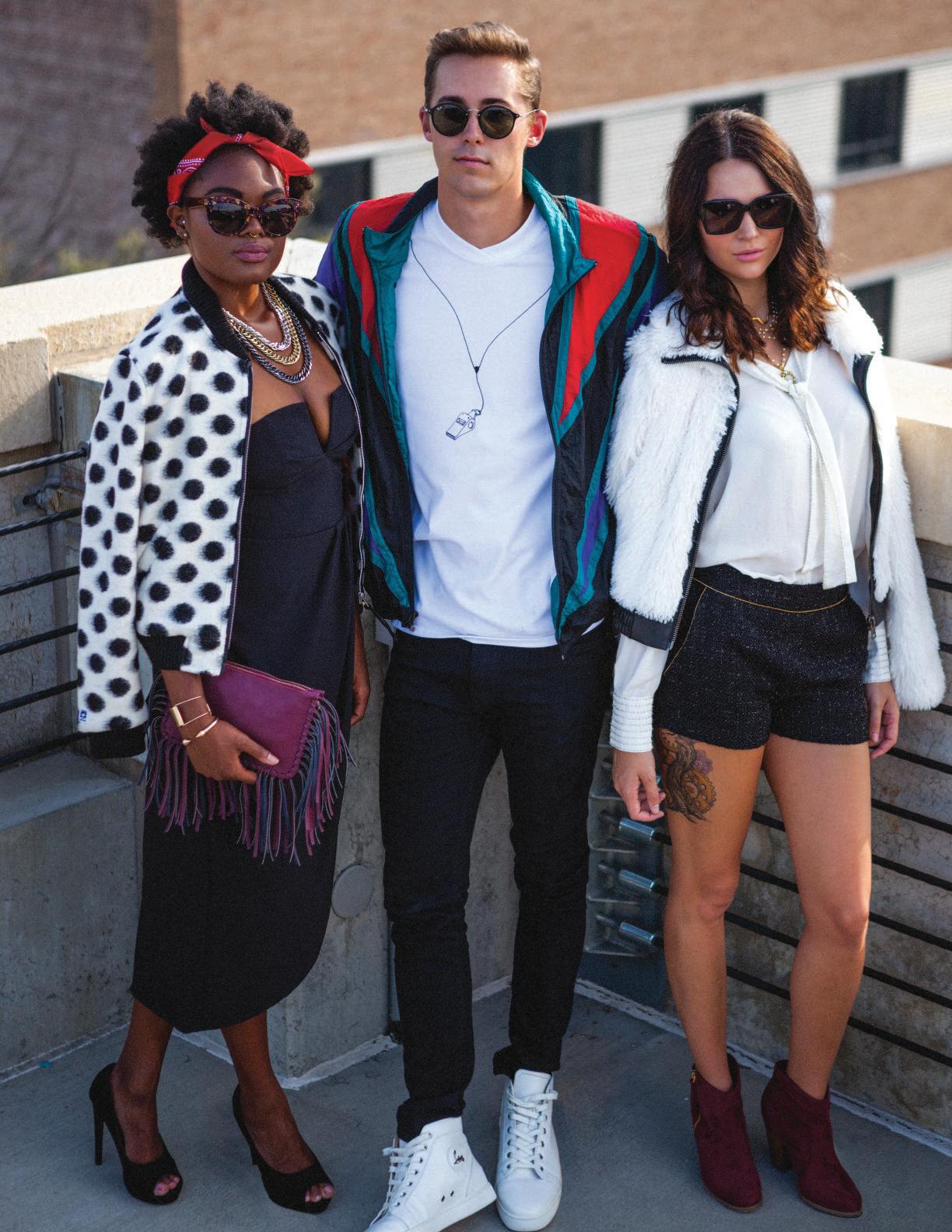
1
|Jacket stylists own | Pants stylists own | Shoes stylists own | shirt Sid & Nancy
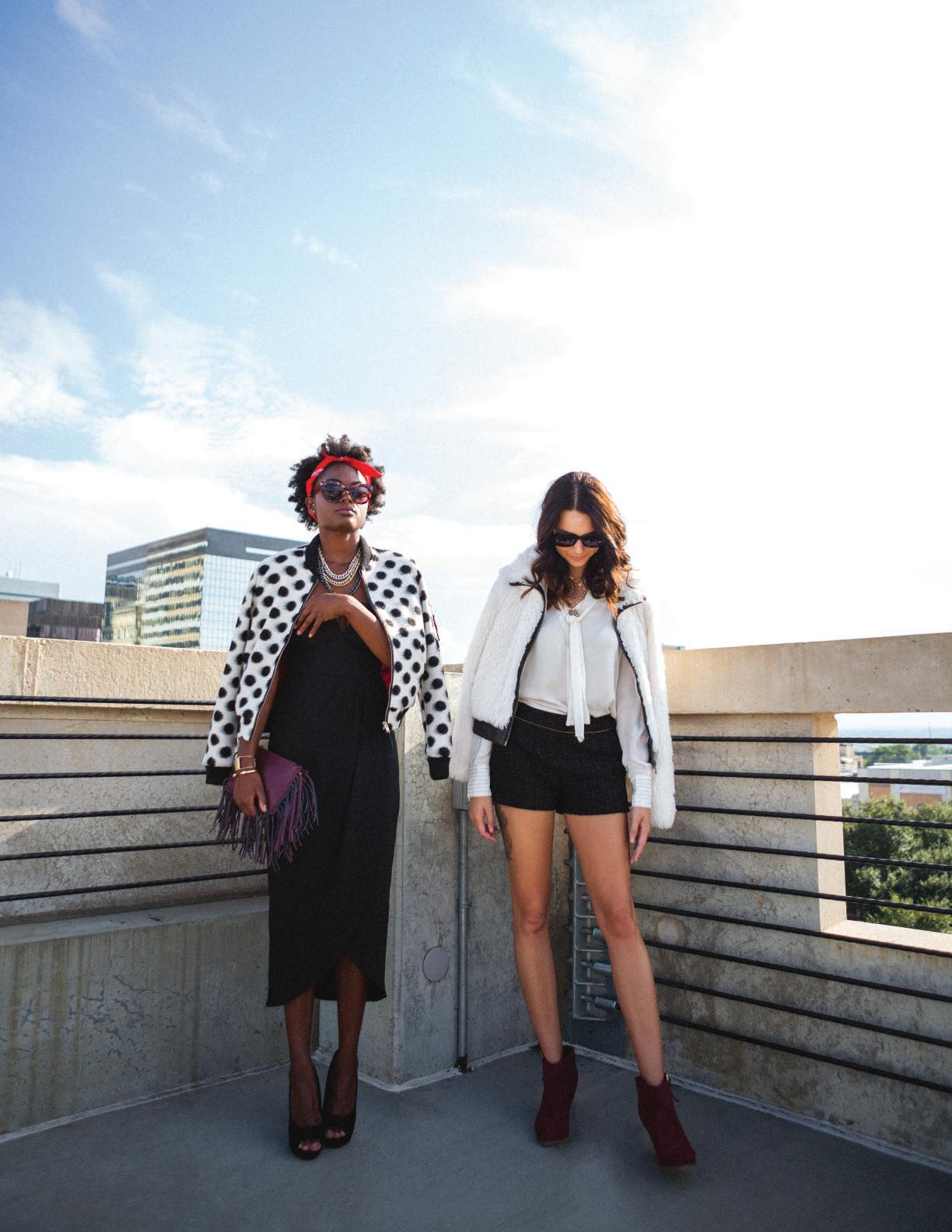
1 2
1|Obey Rhine Jacket Bohemian $148 | Shilla Essence Tube Dress Bohemian $158 | Once in A While bag Vestique $15 | Vestique cuff bracelet Vestique $16 | Krewe du Optic sunglasses Bohemian $195
2|Jacket Steel Garden | Parker top Copper Penny $275 | fab’rik choker fab’rik $25 | VSA Sacred Heart necklace Copper Penny $260 | Shorts Sid & Nancy | Liliana boots fab’rik $52 | Toms sunglasses Copper Penny $139
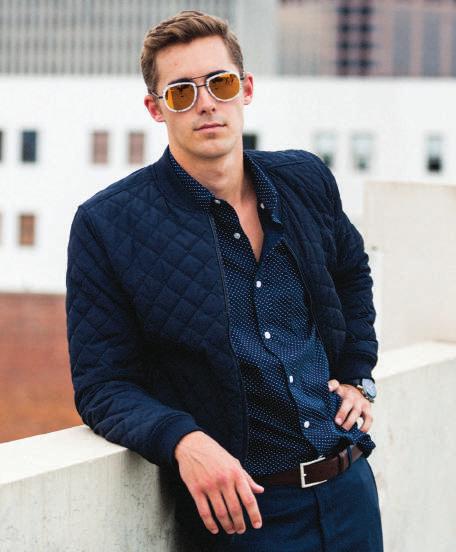
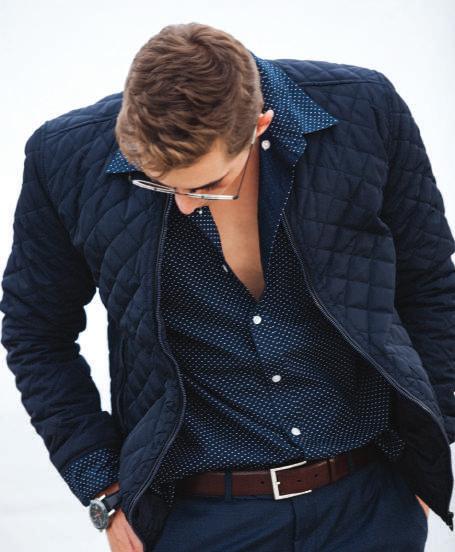

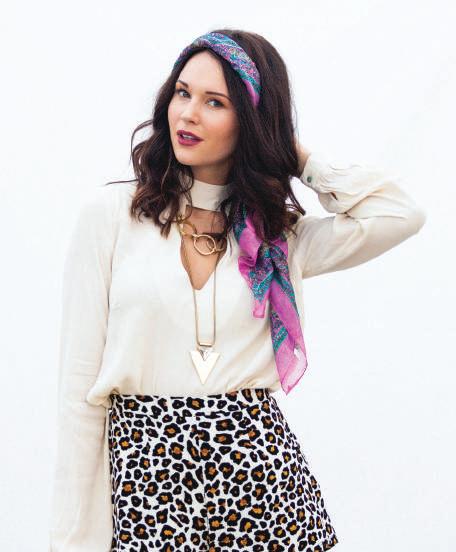
1 2 1|
2|
Bomber stylists own | Shirt stylists own | Dubarry belt Brittons $59 Ballin Brittons $165 | Krewe du Optic sunglasses Bohemian $235
Jenny Bird Big Ring Choker Bohemian $120 | Jenny Bird Shielded Necklace 32” Bohemian $85 | Tribal Spirit scarf Bohemian $18 |
35
Deep V Top fab’rik $62 | Show Me Your Mumu Martine Short Bohemian $88 | Free People Horizon Clog Bohemian $198 | Leibeskin bag Copper Penny $181
|
|
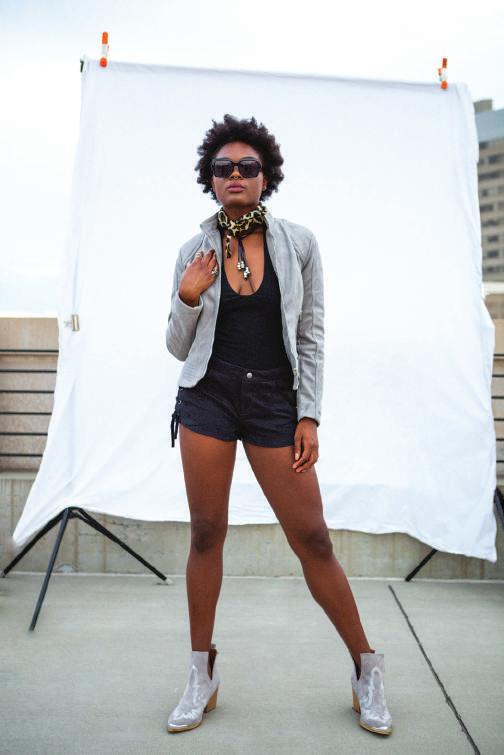

1 2
1
Jacket Copper Penny | Bodysuit Vestique $30 | Shorts fab’rik | Booties Vestique Toms sunglasses Copper Penny $139
36
2
Dress fab’rik $62 | Bag fab’rik $74 | Jenny Bird Hark! Horn Collar Bohemian $225
1|Toms sunglasses
Copper Penny
$119 | Ellie earrings
Vestique $28 |
Tri-Collar Tri-Tone
necklace Bohemi-
an $125 | Buddy
Love Malika Tunic
fab’rik $88 | Overalls

Bohemian | Free
People Horizon Clog
Bohemian $198
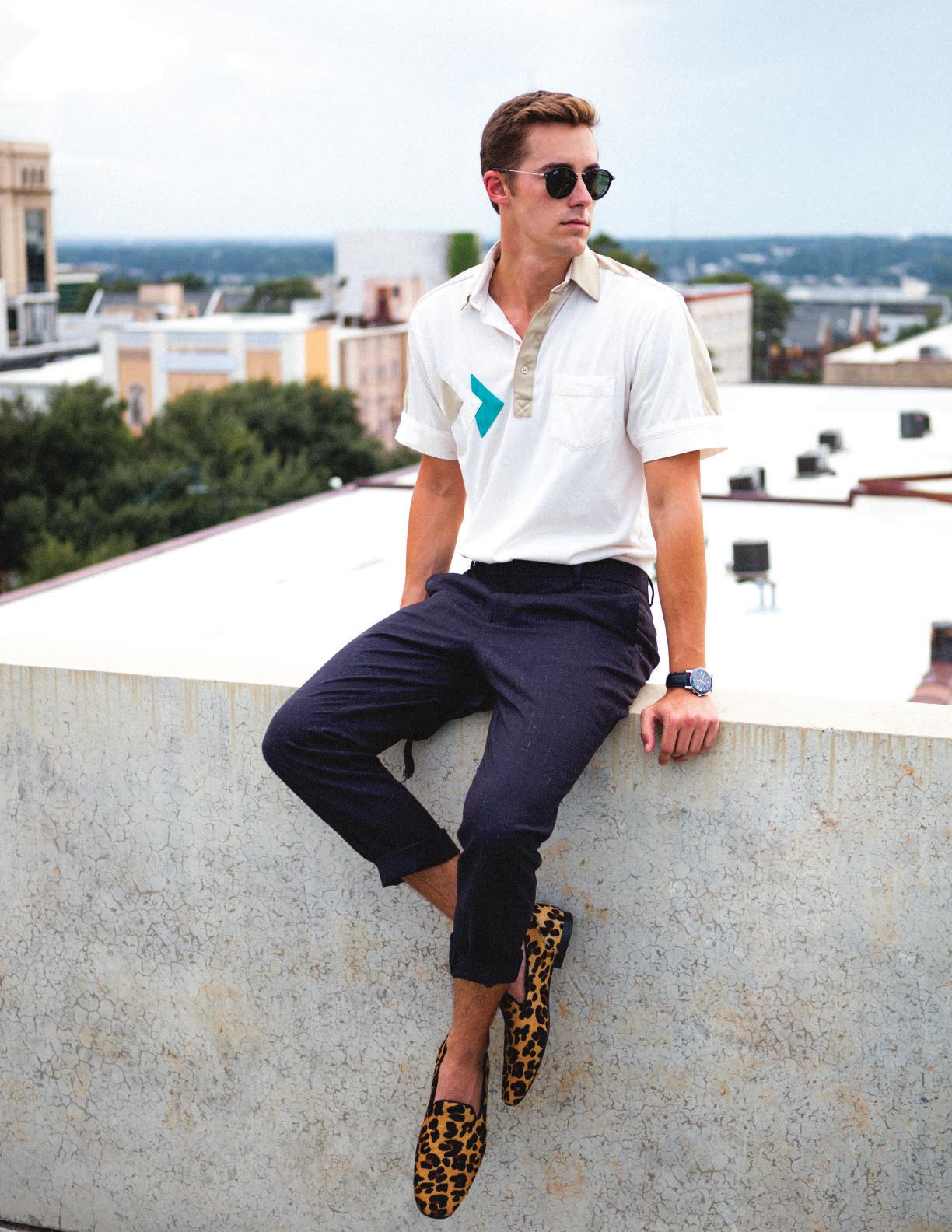
1|Pants stylists own | Shoes stylists own | Shirt Sid & Nancy
Finishing Touches







1 2 4 5 6 7 3
STYLE BY DOMINIC BELLOTTI • PHOTOS BY BRENNAN BOOKER
1 | Love Poppy bangles Copper Penny $18 2 | Leibeskin bag Copper Penny $181, Tribal Spirit Scarf Copper Penny $18 3 | Vintage Sparkle Chain Pearl Bohemian $94 4 | Jenny Bird Shielded Necklace Bohemian $85 5 | Clutch Copper Penny 6 | Love Poppy earrings Copper Penny $20 7 | Krewe du Optic sunglasses Bohemain $195
DESIGN BY RACHEL JOHNSON
DOWN THE RABBIT HOLE
AT THE INTERSECTION OF ART AND BUSINESS, ZOE DALE IS CREATING PIECES YOU’LL NEVER WANT TO TAKE OFF
BY SAVANNAH FISHER • PHOTOS BY BRENNAN BOOKER • DESIGN BY ASHLYN MURPHY
Zoe Dale has been creating jewelry since she was nine. Now in her fourth year, Dale’s passion for meaningful jewelry has only grown. Creativity is a lifelong component of the former art student’s personality. Now, she cites frustration with the lack of quality jewelry in stores as her push to turn something she had always viewed as a hobby into a business.

“The thing that makes you ask someone where they got it, that gets you that interested — it’s always a piece that is unfindable, one-of-akind,” she said.
One-of-a-kind could also appropriately describe Dale and her process. She digs through antique stores. She chisels pieces of amethyst off larger stones for necklaces and bracelets. She wraps wires and stamps letters on charms. She does marketing and manages a brand Instagram and Etsy page. Her products are packaged with a label she designed: a running rabbit, blindfolded, encircled by a ring of flowers. Bold letters read: BLIND RABBIT. The logo is originally a tattoo idea she conceived for herself, drawing from a series of experiences in her life, including being vegan for two years. All of her materials are sourced from local businesses. Specifically, she purchases from
Swift Water Beads & Jewelry in Columbia. Because she knows their product’s origin, she’s certain that it comes from ethical suppliers.
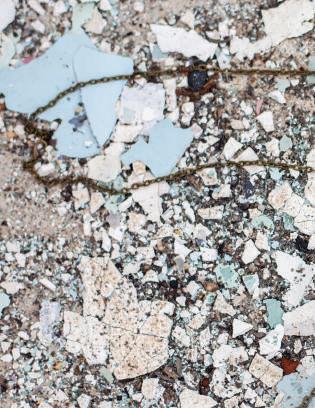

Dale shows us that jewelry can make powerful statements. A hand-stamped metal charm reads GIRL GANG. She said, “I’m really passionate about feminism and equal rights, and I think
Girl Gang is a really cool concept and way of just getting it out there and showing the world where you stand.”
We had a conversation about how it was recently discovered that the clothing brand Zara has been selling pieces nearly identical to accessories produced by indie brands like Blind Rabbit. Dale commented that,

40 ARTIST IN RESIDENCE
while it was poor business practice on the part of Zara, it only goes to show that the demand is there for unique pieces produced by artists like her.
Dale’s jewelry is art, not just a product. It is carefully crafted to last a lifetime, not a fashion cycle. It is deeply personal, whether rebuilding pieces from her great-grandmother or creating custom pieces with materials significant to the


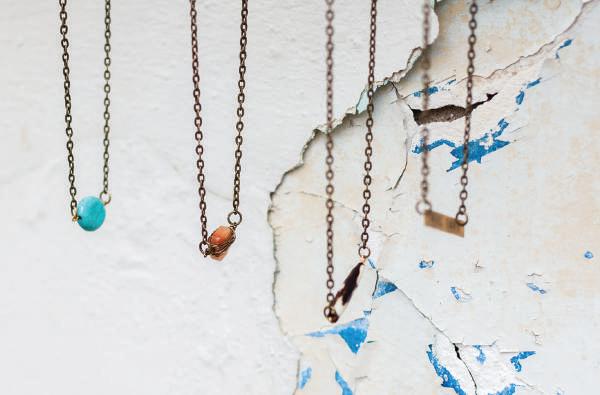
customer. In terms of her future, Dale wants to expand Blind Rabbit and improve her skill, potentially abroad, and always with a mind to increase the originality of what she makes.
“I don’t think I will fully feel like an artist until I know how to solder, to wax cast, until I’m creating everything,” she said. “Once I can do that, then I’ll feel like an artist, and I can’t wait for that.”
“
DALE’S JEWELRY CAN BE FOUND AT SID & NANCY AND AT ETSY.COM/SHOP/THEBLINDRABBIT 41
GIRL GANG IS A REALLY COOL CONCEPT AND WAY OF JUST GETTING IT OUT THERE AND SHOWING THE WORLD WHERE YOU STAND.”
POWER TO THE SKANKS DEBBIE AND THE SKANKS
BY KASEY MEREDITH • PHOTOS BY CAROLINE MOORE • DESIGN BY ALEX RUSNAK
THE PROBLEM WAS, Debbie didn’t want to be a skank.
“I spent all of middle school making sure people didn’t call me that,” she says.
A jam-session-turned-audition later, and Deborah Adedokun became the frontrunner of Joe “Buck” Roberts’ band, previously the Buck County Skanks. She joined the band with Roberts on guitar and vocals, Brett “Hound Dog” Kent on bass and Adam “Ol’ Unk” Cox on drums. She says she got tricked, but she doesn’t regret it. Now, the band possesses a powerful stage presence and the sense of the old being made new again.
Roberts wanted the
band to be female-fronted. Debbie had qualms about being a skank because she was nervous about performing in front of the crowd. In the beginning, she apologized for messing up during shows, but according to Roberts, the crowd never noticed.
“We would just be like, ‘Oh, she’s doing the chorus again. I guess we’ll do that,’” he says.
Adedokun sees the stage fright as part of the experience. Even though they’ve been together for two years, she says that if she didn’t still get nervous before a show, she would quit.
“If we were about to play a set and I wasn’t all jittery
and freaking out, I would be over it,” Adedokun says.
The band is working on recording an album that they want to press into vinyl, and they have a live-recorded album accessible through BandCamp, but they thrive on the stage.
To say a Debbie and the Skanks show is lively would be an understatement. They don’t play as often as they used to because bassist Kent moved to Asheville, but when they do, it’s a show all its own. Adedokun uses the stage as an instrument in and of itself, jumping and stomping to the beat and dancing with the mic stand.
“When hurricane Deb hits the stage, you goin’ do it,”
Roberts says.
Adedokun is obnoxious and in-your-face.
“My partner over there in the blue T-shirt ain’t doing nothing over there. Clap your hands; It ain’t gonna hurt you,” she harped at one show in Charleston.
Roberts describes Debbie and the Skanks as good ole rock ‘n’ roll, taking something old and making it new again. The music is gritty, obnoxious garage rock — The Stooges of Columbia. Roberts’ guitar riffs are unpolished and warped, yet melodic. Through this hard, jagged, upbeat percussion, Adedokun delivers powerful vocals about heartbreak and

42 SCENE & HEARD
ROCK ‘N’ ROLL IS ABOUT EMPOWERMENT. IT ALWAYS HAS BEEN.”
revenge.
Having a female frontrunner wasn’t just luck of the draw. There’s a sense of politics in the act. For young girls coming to a Debbie and the Skanks show, Adedokun wants them to see the band as empowering.

“I don’t like it to be any different than if Joe were the one singing, but I do like the idea that other girls will see it and say, ‘Oh, this is totally normal and awesome and fine,’” Adedokun says.
Roberts didn’t want Ade-
dokun to be the lead singer just for the sake of having a female-fronted band.
“I don’t want having a black person or a female to be a novelty. Some people will see it as that, but others will see it as empowering,” he says. “Rock ‘n’ roll is about empowerment. It’s always been about empowerment, making people feel empowered,” says Roberts, “and everyone should have the space to do that.”

43
ON THE AIR
CATCH “DARK ENTRIES” ON WUSC 90.5 FM EVERY SATURDAY NIGHT, FROM 8-10 P.M.
BY CASSIDY SPENCER • PHOTOS BY CHRISTIAN TOLBERT DESIGN BY TORI MCANALLEN
David Wood (DJ D) is a media arts major specializing in video production and editing with the ultimate goal of working in Los Angeles or New York as a producer. In the meantime, he’s had a long-running radio show here with WUSC, “Dark Entries: Goth Radio.” The show features largely Gothic Rock, but also branches out into various dark genres and doom metal.
HOW DID YOU FIND YOURSELF IN THE WORLD OF GOTHIC ROCK?
There was a record company called Cleopatra records that produced most of your major goth bands, and the first goth compilation of theirs is just called “Gothic Rock”. I found that compilation on cassette when I was 15, at a store in Myrtle Beach – my cousin actually showed it to me and said, “This might be something that you could get into.” So we spent the rest of the trip just riding around in his truck, listening to that tape on repeat.
WHAT DO YOU SPECIFICALLY LIKE ABOUT GOTH RADIO?
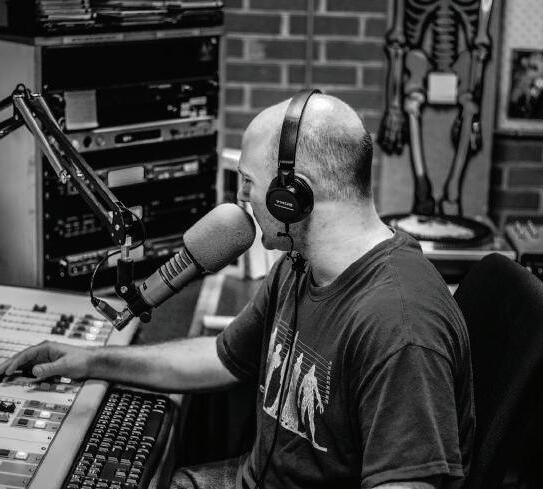
I like it because it is multi-faceted – under the umbrella of what is called “gothic rock” there are so many different sub-genres and sounds that people don’t realize. It also appeals to people who look at the world in a different way, in a sense that I see sort of beauty in horror in the world all the time.
IF YOU WERE TO TRY TO GET MORE STUDENTS INTO GOTHIC ROCK, WHAT WOULD YOU SAY ABOUT IT?
Don’t be scared of it. The main misconception about it is “Oh, you’re so weird,” and “It’s all about satanism and devil worship.” If anything, it has a sense of humor. When you go to see a horror movie, you’re not going because you worship the devil; you just want to have a good time. I mean, yeah, there are some darker aspects to it, but life is hard. And people go through things. If you think about it, gothic music is not very different from blues music. They both stem from a similar place. People need ways to get through the hard parts of life.
BY BAUHUAS
BY ASYLUM PARTY
BY THE DAMNED BY SOUTHERN DEATH CULT BY NOSFERATU
44 ON THE AIR
WE CALL THE SHOTS
BY KATHLEEN SCHIPANO • PHOTO BY JOSH THOMPSON • DESIGN BY ASHLYN MURPHY
A 200 percent increase in the number of students hospitalized for alcohol consumption does two things: makes me feel sorry for the ER nurses at Palmetto Baptist and scares the ever-loving hell out of me. If freshmen are out there hurting themselves in mass quantities, and we’re all watching it happen, then we are all screwing up in a major way.
I remember taking AlcoholEdu before coming to school. I remember it being a module with simple questions — something designed to be passed. As for the content of the course?
Beer, wine and liquor have different alcohol volumes. That, and the fact that the mitochondria is the power house of the cell, and that Eli Whitney invented the cotton gin, was the knowledge I came into college with.
The first time I got drunk, I was lucky. It was on moscato or rum and Cokes, or something equally sad and available. I sat in my best friend’s apartment with a ton of people I still love and trust to this day. I think we played board games. The luckiest part was when an older girl took both my hands and told me things that may not be scientifically accurate,
but they stuck.
1. If you close your eyes and you feel like you’re spinning, stop drinking and switch to water.

2. Drink a big glass of water and eat some carbs before bed.
3. Once you break the seal, be prepared to pee constantly. The best AlcoholEdu you will ever have will come from your friends. So we, as upperclassmen, need to GIVE that education and teach those lessons. The best friends I have will take my drink away and make me finish a whole glass of water before they give it back, and
I will do the same for them. We need to do that for these people who clearly have a warped perception of what it means to enjoy alcohol. We can sanction and point fingers and “re-educate” all we want. Unfortunately, that all operates under the assumption that college students are going to stop drinking and stop finding ways to drink. They aren’t. Also, there is only so much that statistics and facts and figures can do. At the end of the night, it becomes our responsibility to mentor, and to care for these people who are hurting themselves. We need to talk to them, because we have been through what they are going through.
Bottom line: How are we going to blame it on the alcohol and not ourselves? Because alcohol is going to keep doing its thing, but we have the choice to keep letting kids get hurt or grow some responsible new Carolinians.
45 RANT
IF YOU CLOSE YOUR EYES AND YOU FEEL LIKE YOU’RE SPINNING, STOP DRINKING AND SWITCH TO WATER.
EVENTS
WHAT TO LOOK OUT FOR IN COLUMBIA THIS FALL.
BY ATHENA MAROUSIS • PHOTO BY SARAH CASSIDY DESIGN BY ASHLYN MURPHY
SOUTH CAROLINA STATE FAIR

2ND ACT FILM FESTIVAL
South Carolina’s annual state fair is back! Grab some friends, grab some food and hop on your favorite ride. For the first time, fairgoers can purchase an advance $25 voucher that gets you pay-one-price rides all day, even on weekends. Order yours online before Oct. 12 to take advantage of this discounted price, a great opportunity for those out-of-state students that have never experienced the state fair.
GERVAIS STREET BRIDGE DINNER
Forget your typical Friday night movie and come out to enjoy original screenplays written, directed and filmed by South Carolina’s very own up-and-coming filmmakers. Contestants are given the first and third acts of a screenplay and are left to fill in the second act however they choose. You will get to watch the entire film and experience each artist’s unique approach to the project. The festival is hosted by Jasper magazine and will be held at Tapp’s Arts Center.
CRAFTSMEN’S CLASSICS ART AND CRAFTS FESTIVAL
This event was hosted for the first time last year to aid in the healing process of multiple flood-ravaged cities and honor first responders. After great success, it has returned this fall to continue raising funds for local charities, including Heroes in Blue, a non-profit dedicated to bridging the gap between communities and their local police. Guests will enjoy a seated, sunset dinner along with live music, local artists and performances throughout the night. Visit gervaisstreetbridgedinner.com to purchase tickets.
Witness the creative process of hundreds of artists and craftspeople at this festival, and even a purchase a knick knack or two. Find beautiful decorations, artwork and jewelry; the wide selection of holiday gifts offers something unique for all tastes. Sunshine Artist Magazine has ranked the event among the «100 Best Classic & Contemporary Arts & Crafts Festival.»
The festival is hosted at 1200 Rosewood Drive. Tickets are $8.
46 EVENTS
OVERHEARD AT PRIDE
The G&B staff attended Columbia’s Famously Hot SC Pride and collected colorful quotes in the process.
 BY G&B STAFF • PHOTOS BY JOSH THOMPSON • DESIGN BY ELIZABETH JENNINGS
BY G&B STAFF • PHOTOS BY JOSH THOMPSON • DESIGN BY ELIZABETH JENNINGS
“I’M REALLY REGRETTING MY 9 A.M. MARGARITA.”
“OK, sorry in advance, but who is RuPaul?”
“MOM, I REALLY OVERDID THE DAY DRINKING.”
“WHERE THE HELL HAS JORDIN SPARKS BEEN FOR THE PAST FOUR YEARS?”
“YAAAASSSSSS GRANDMA!”
“Do you think they’ll give me a free beer with this Livestrong bracelet on?”
“I’M JUST WONDERING WHO’S HERE FOR THE FARMERS MARKET AND WHO’S HERE FOR PRIDE.”
“THE GAY AGENDA IS REAL!”
“I’m kind of mad there are no protestors. I wanted to scream at someone.”
“I’M DANCING THROUGH THE HEATSTROKE!”
“IT SUCKS THAT MY DOG CAN’T SEE THE RAINBOWS. I THINK SHE WOULD LOVE THEM.”
“Nothing lasts like a drag queen’s make up.”
[ [
[ [
47 OVERHEARD AT

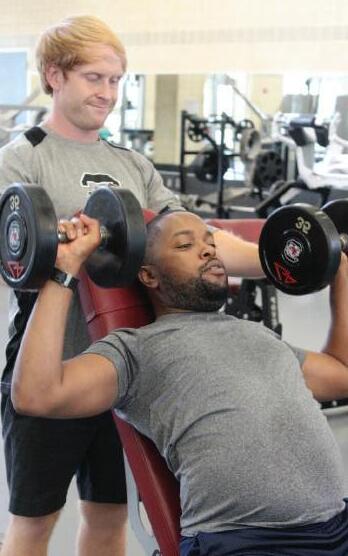


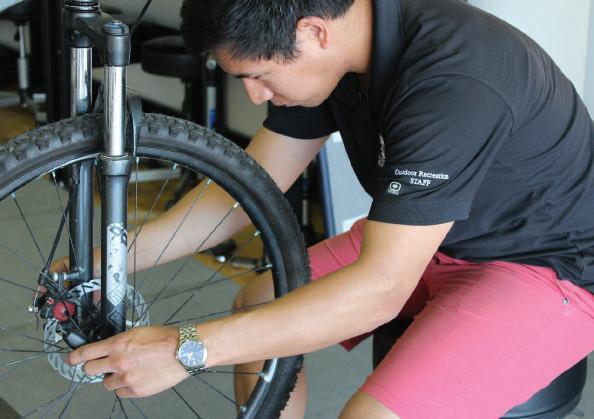
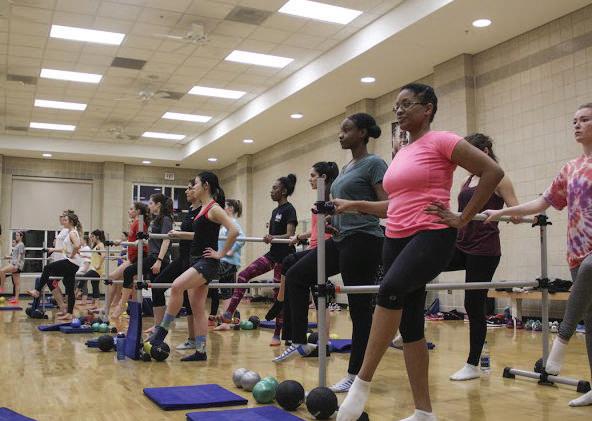











 BY KATE STUCKY • PHOTOS BY JOSH THOMPSON • DESIGN BY RACHEL JOHNSON
BY KATE STUCKY • PHOTOS BY JOSH THOMPSON • DESIGN BY RACHEL JOHNSON








 BY JAKE MARGLE • PHOTOS BY BRENNAN BOOKER
DESIGN BY RACHEL JOHNSON & CHARLOTTE PRICE
ILLUSTRATION BY ALEX RUSNAK
BY JAKE MARGLE • PHOTOS BY BRENNAN BOOKER
DESIGN BY RACHEL JOHNSON & CHARLOTTE PRICE
ILLUSTRATION BY ALEX RUSNAK



















































 BY LOIS CARLISLE
BY LOIS CARLISLE


 BY BEN CRAWFORD • PHOTOS BY JOSH THOMPSON • DESIGN BY CHARLOTTE PRICE
BY BEN CRAWFORD • PHOTOS BY JOSH THOMPSON • DESIGN BY CHARLOTTE PRICE











































 BY G&B STAFF • PHOTOS BY JOSH THOMPSON • DESIGN BY ELIZABETH JENNINGS
BY G&B STAFF • PHOTOS BY JOSH THOMPSON • DESIGN BY ELIZABETH JENNINGS





